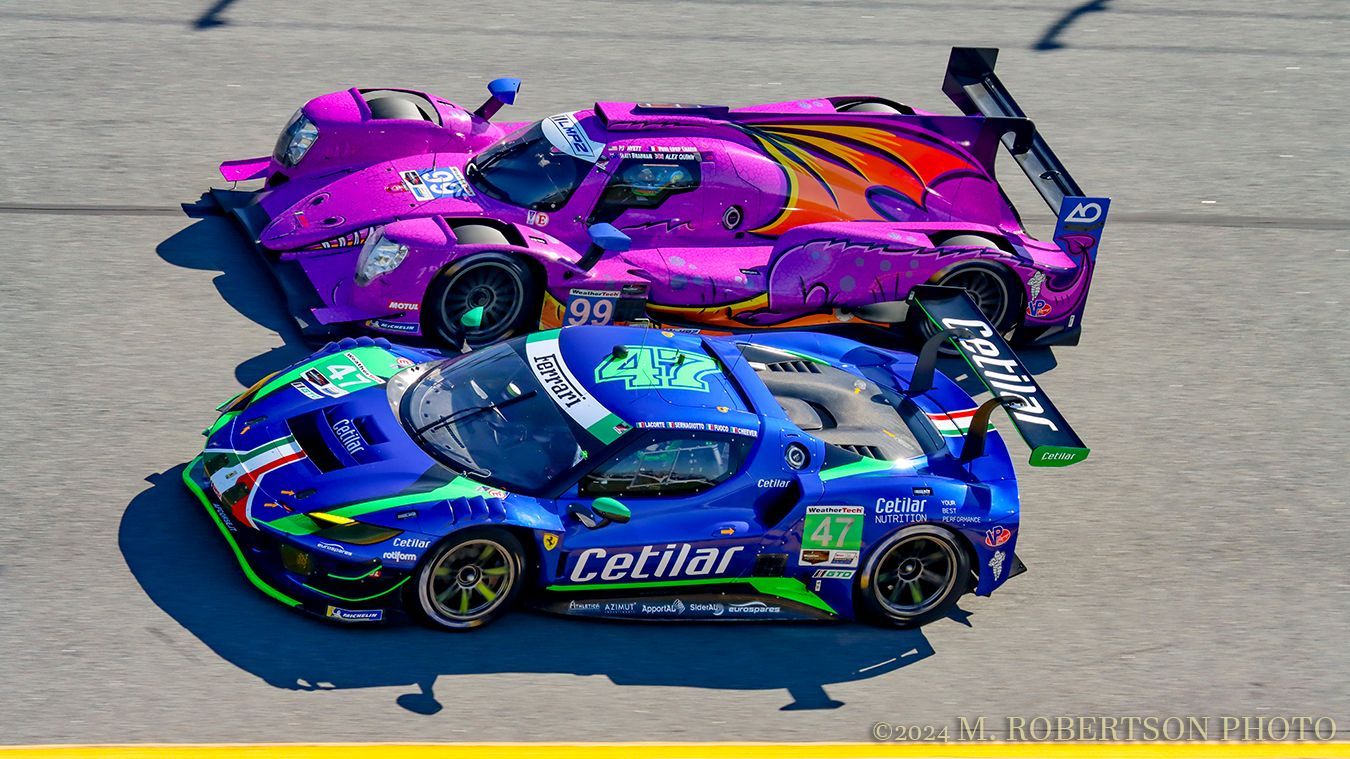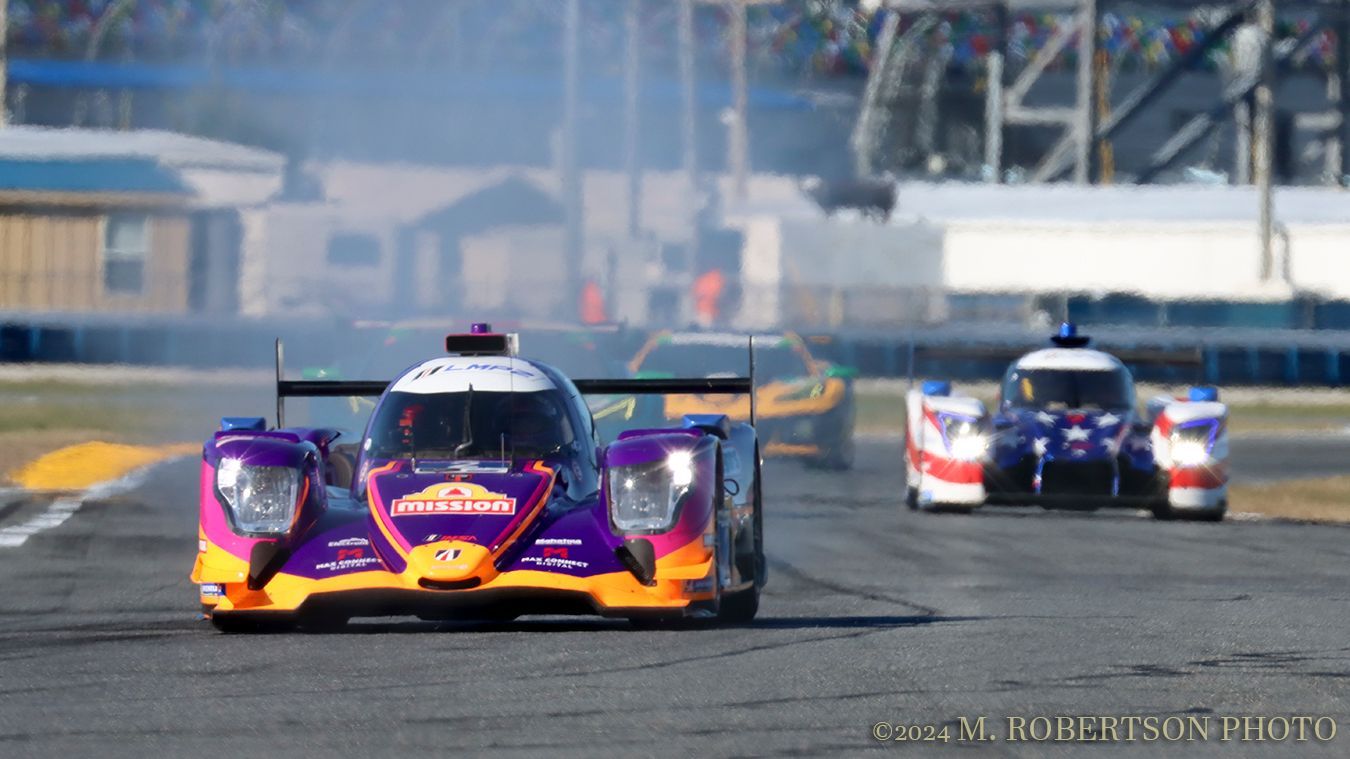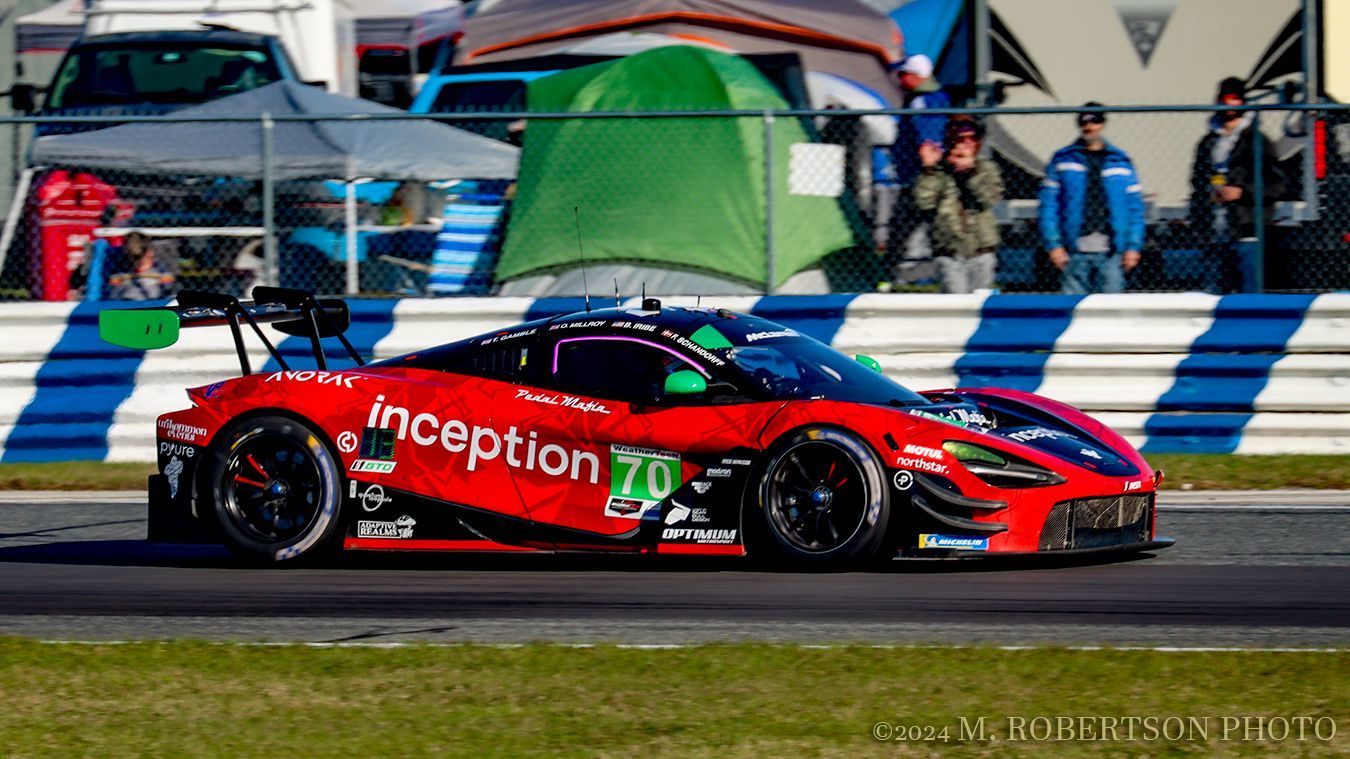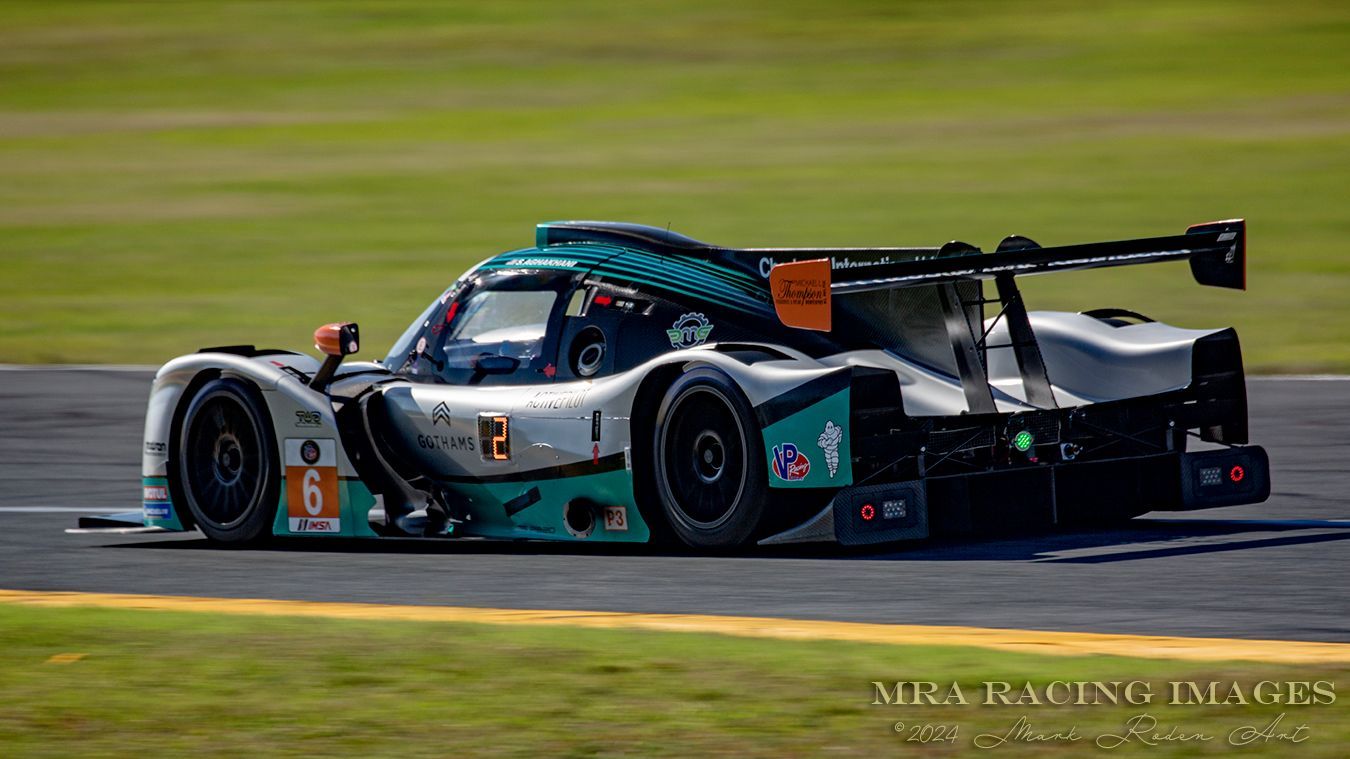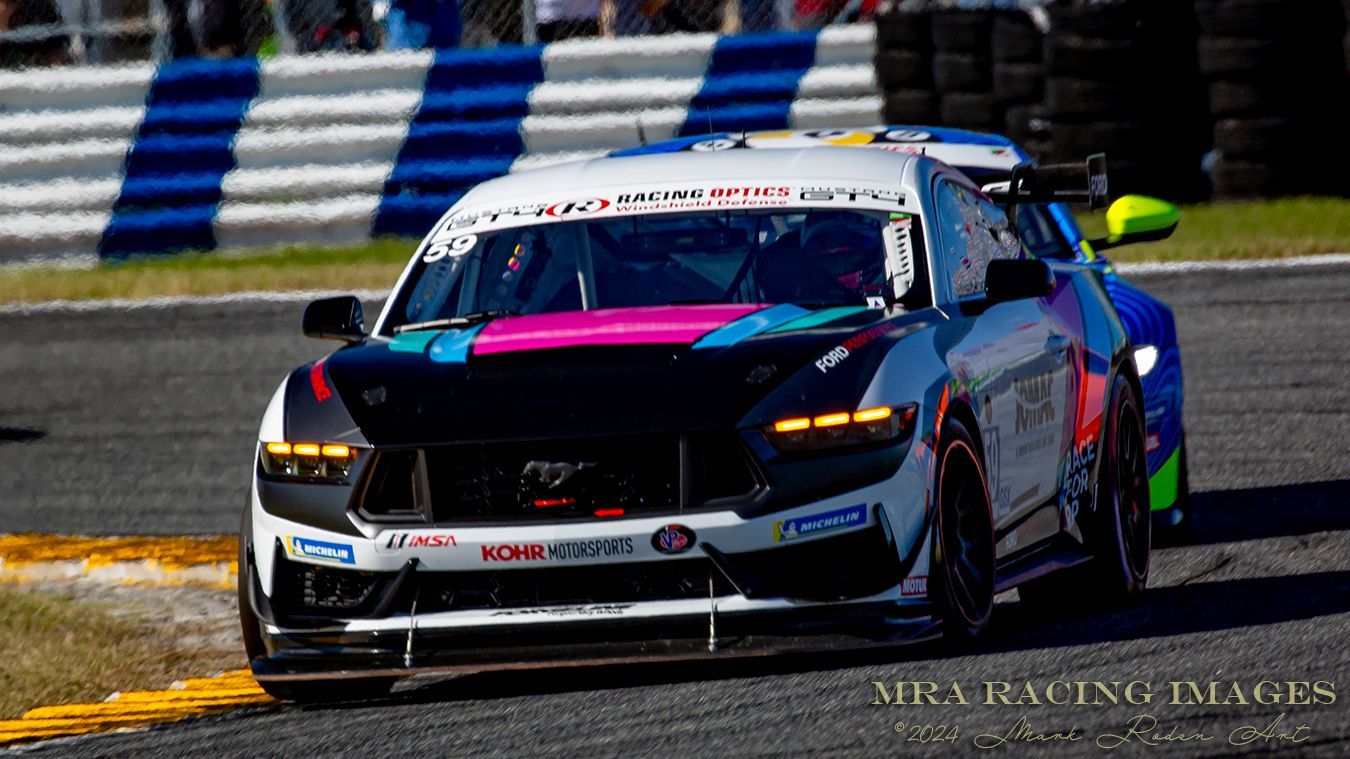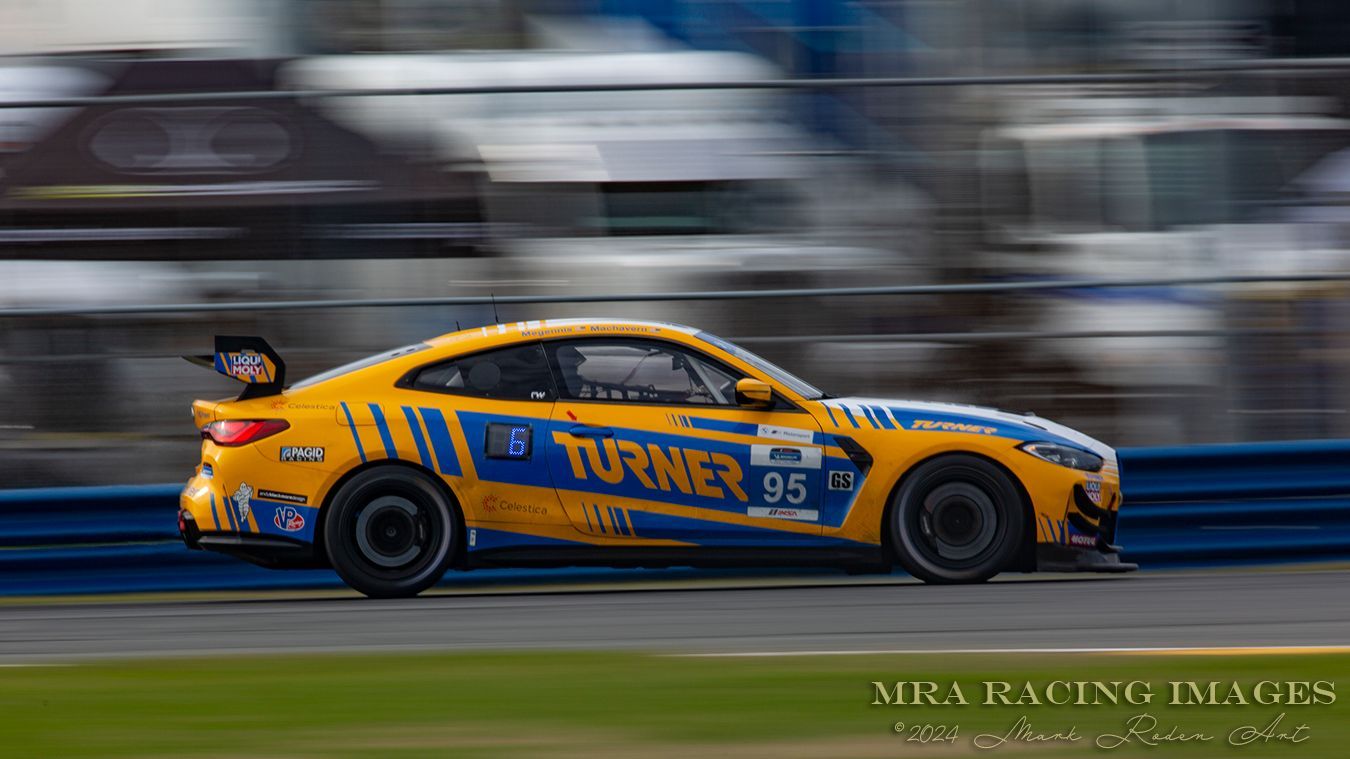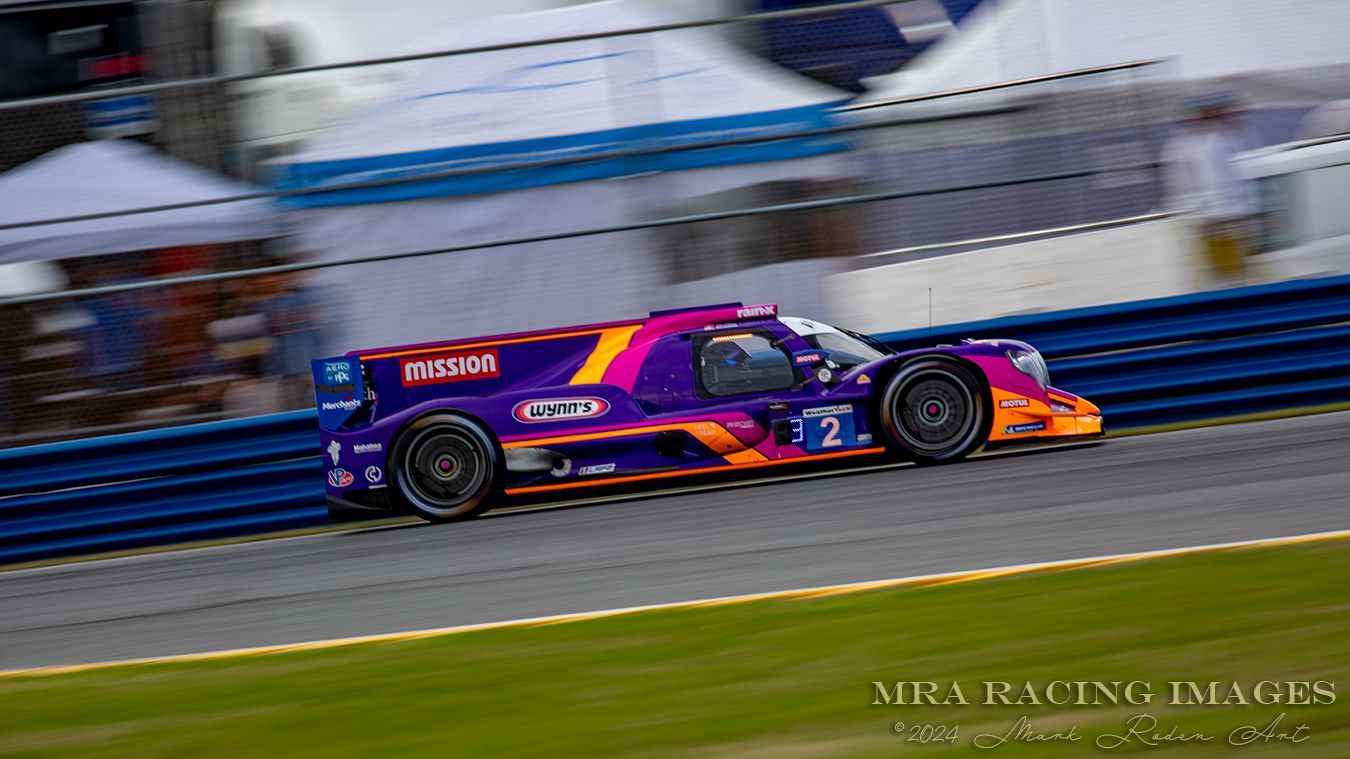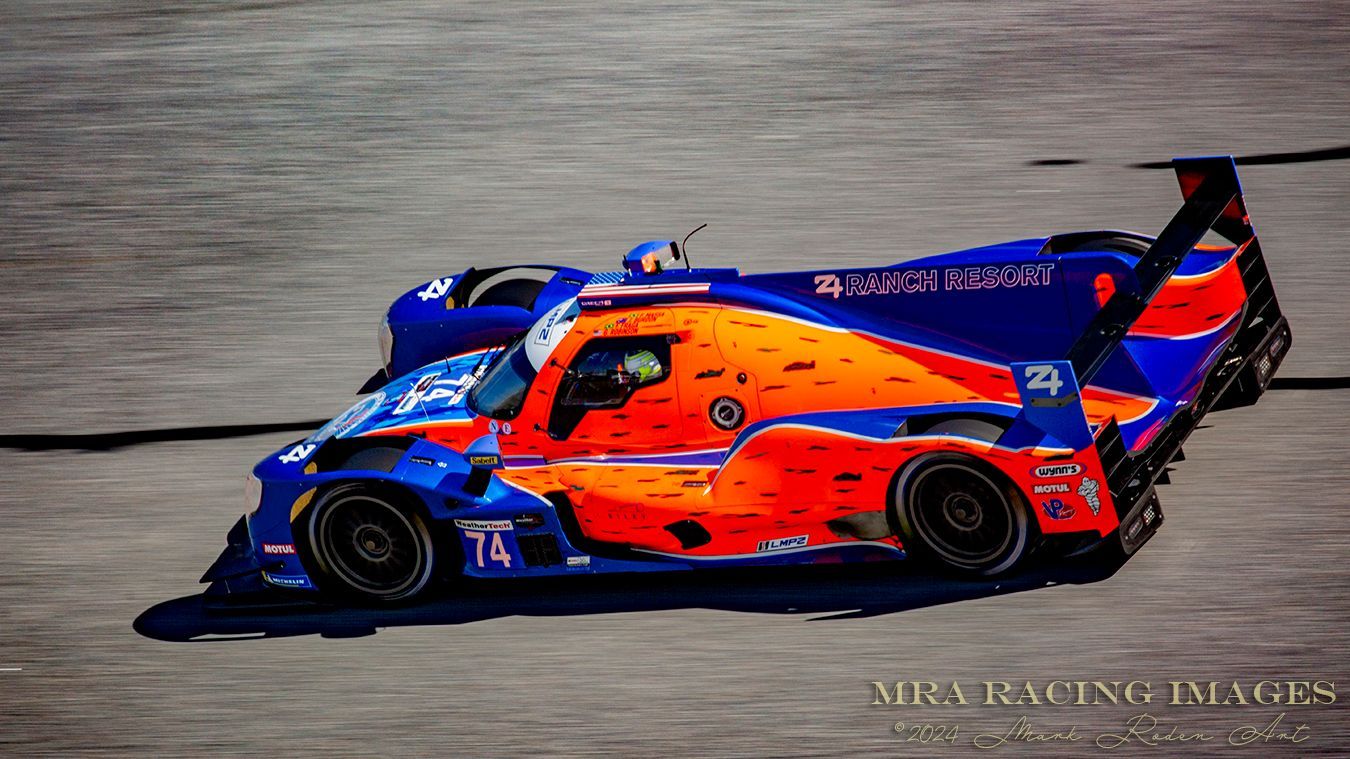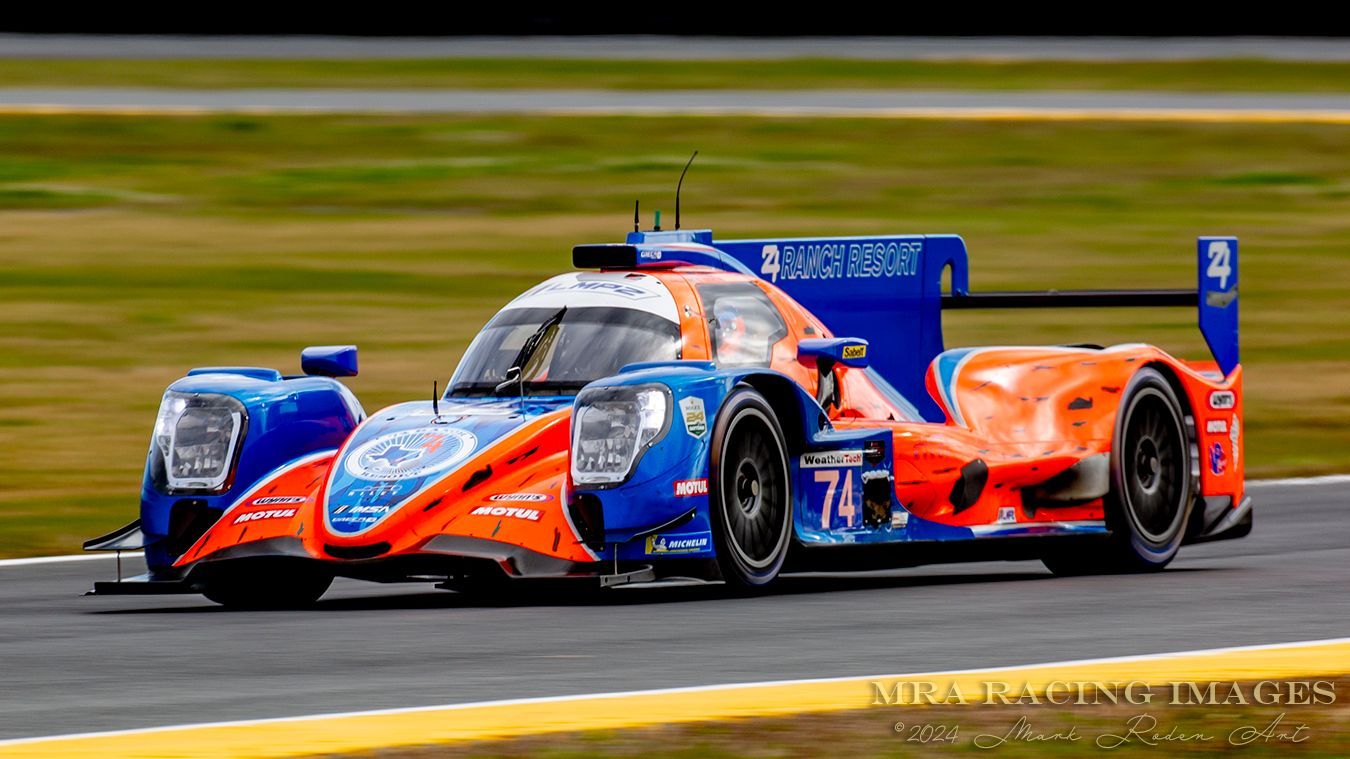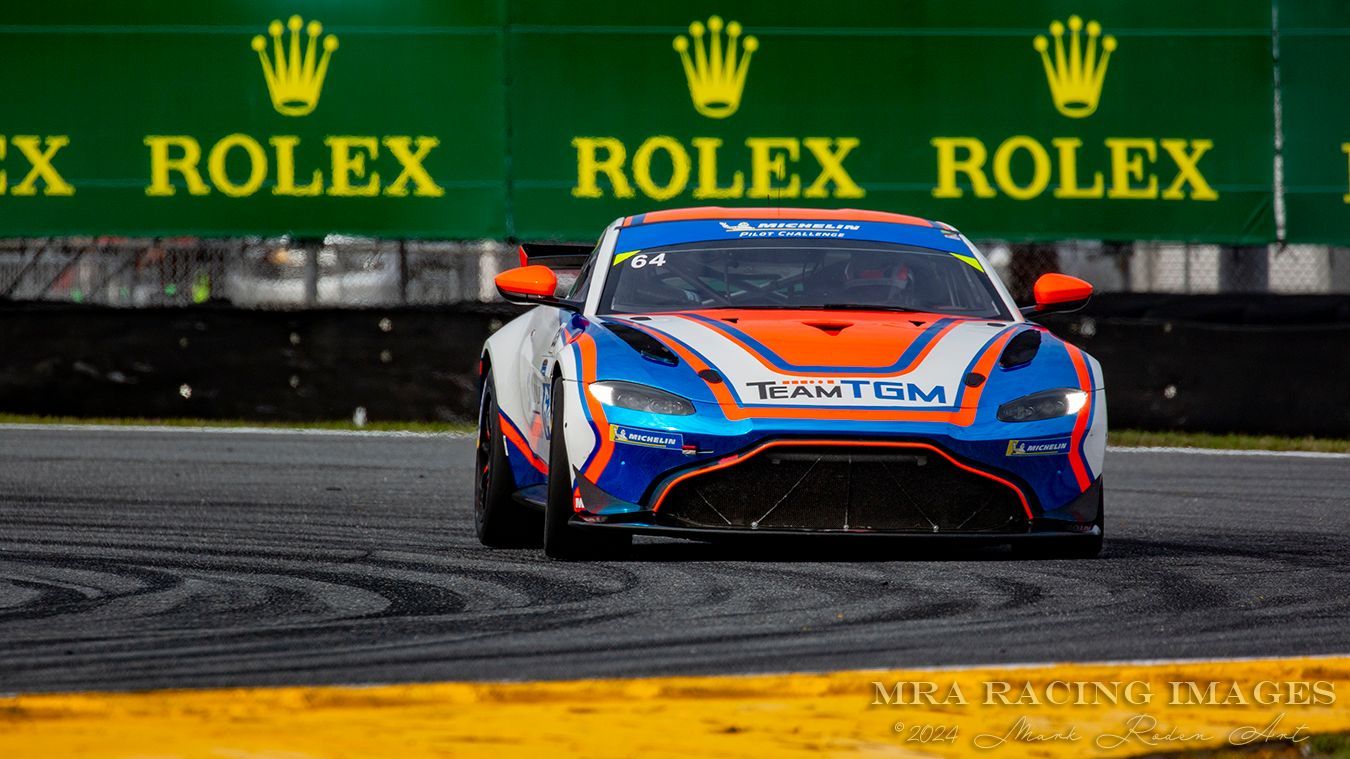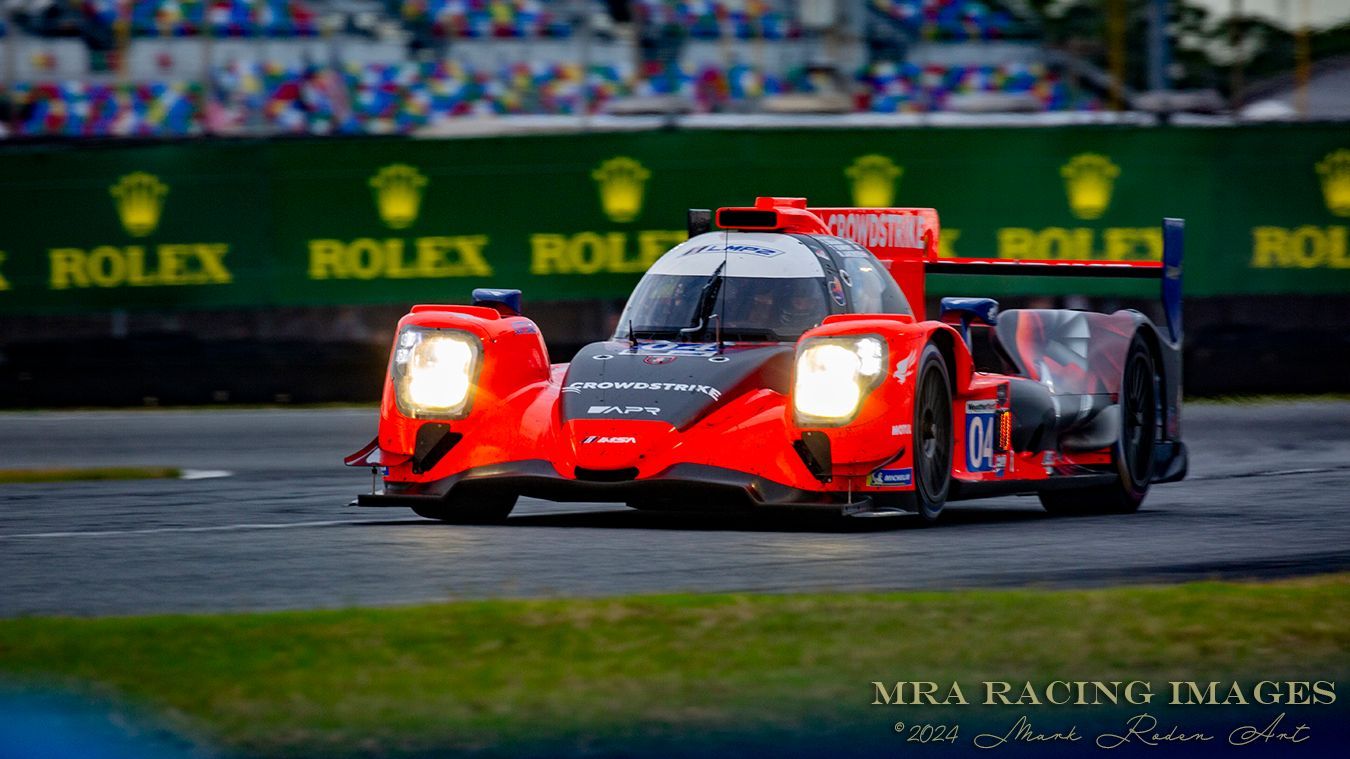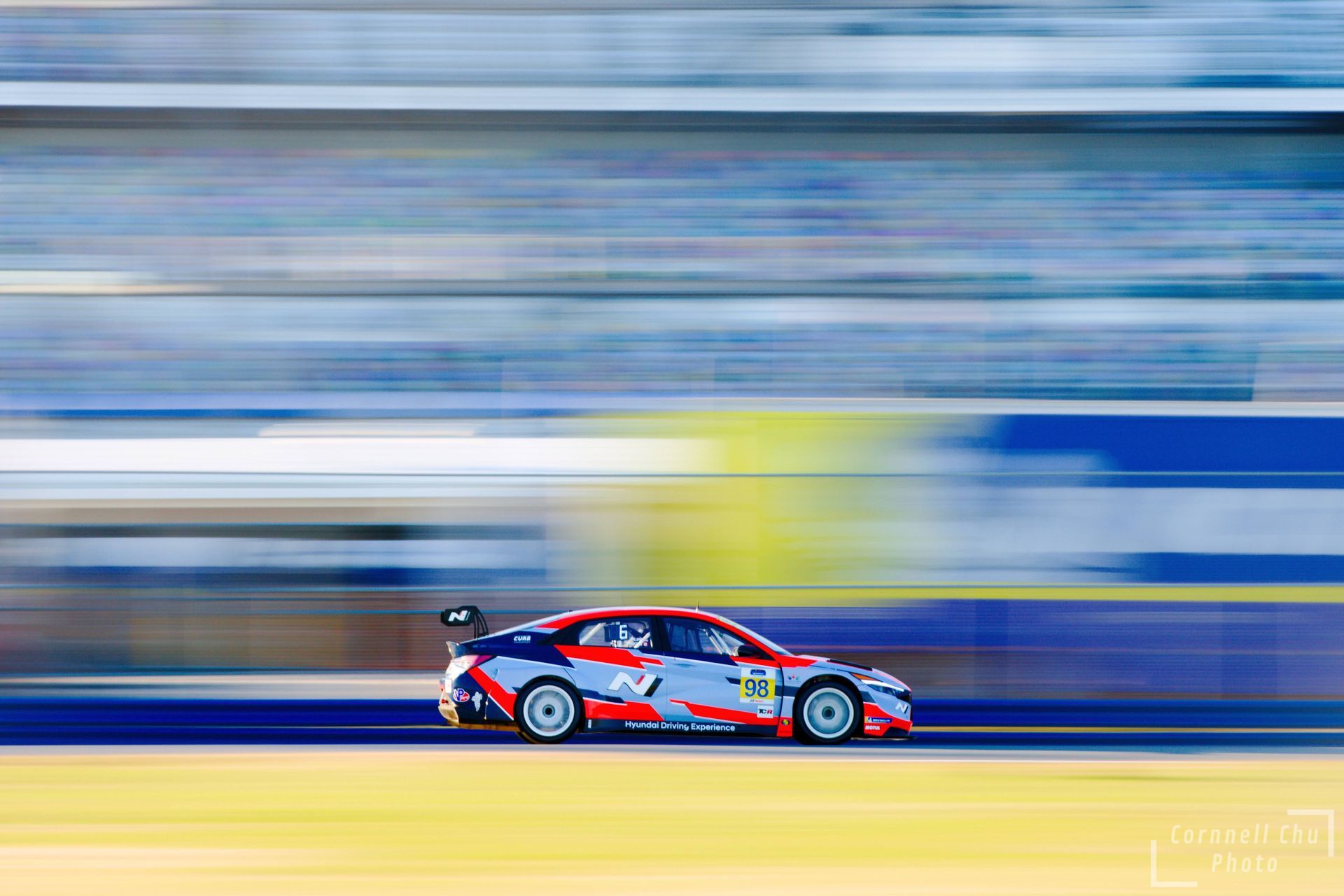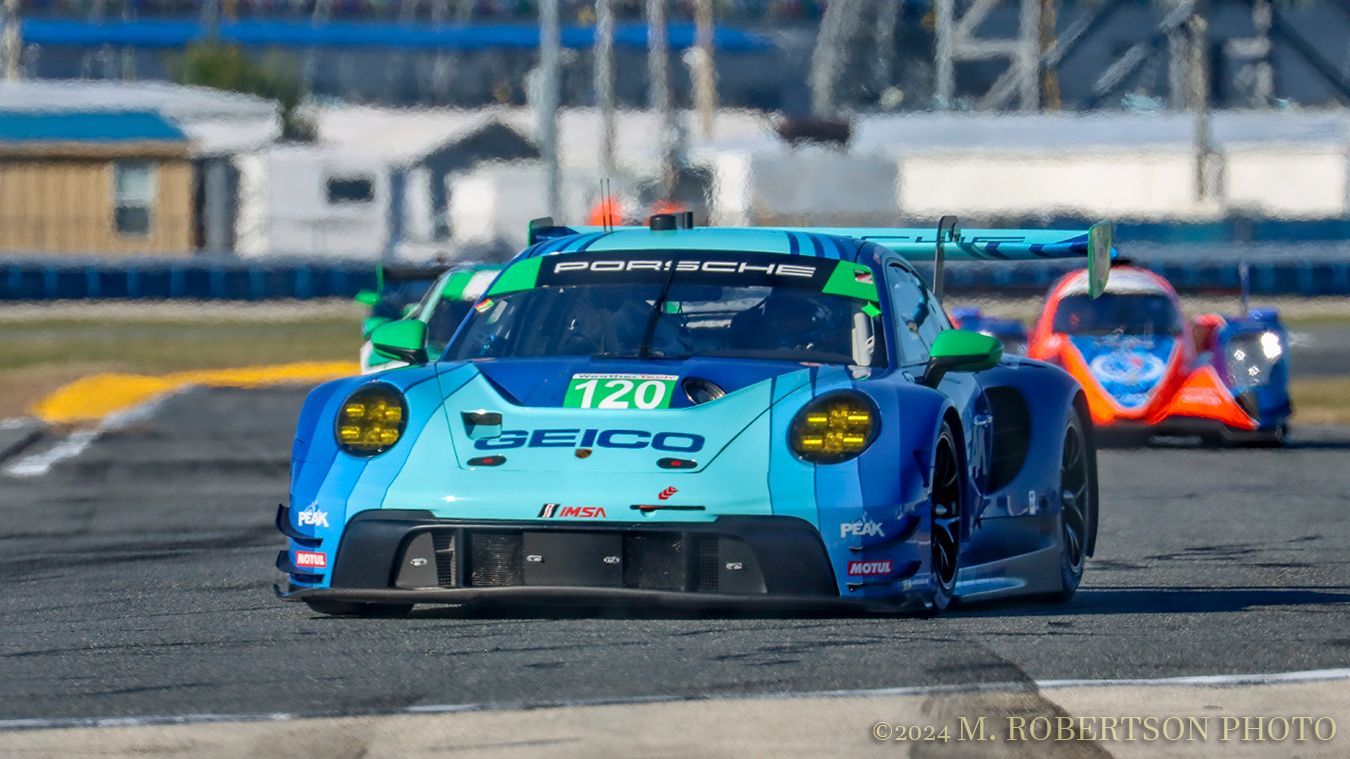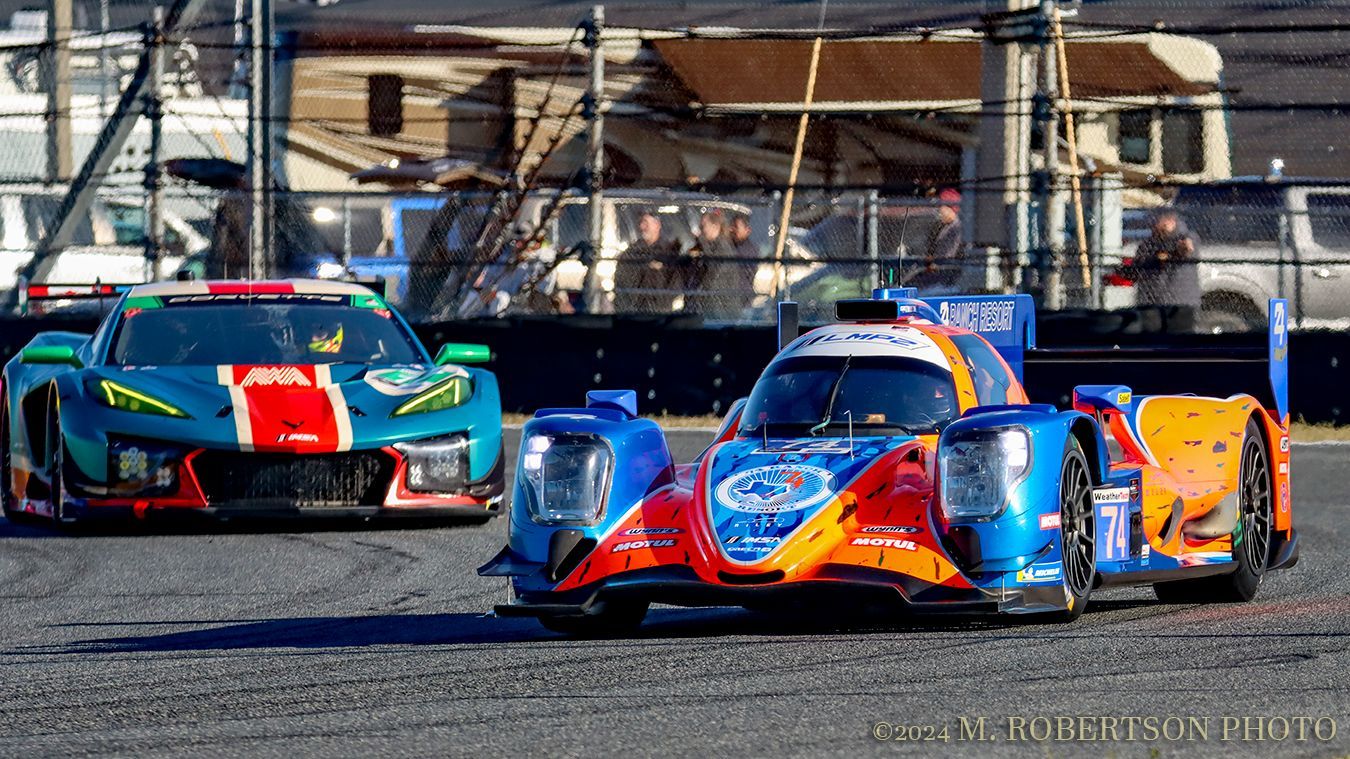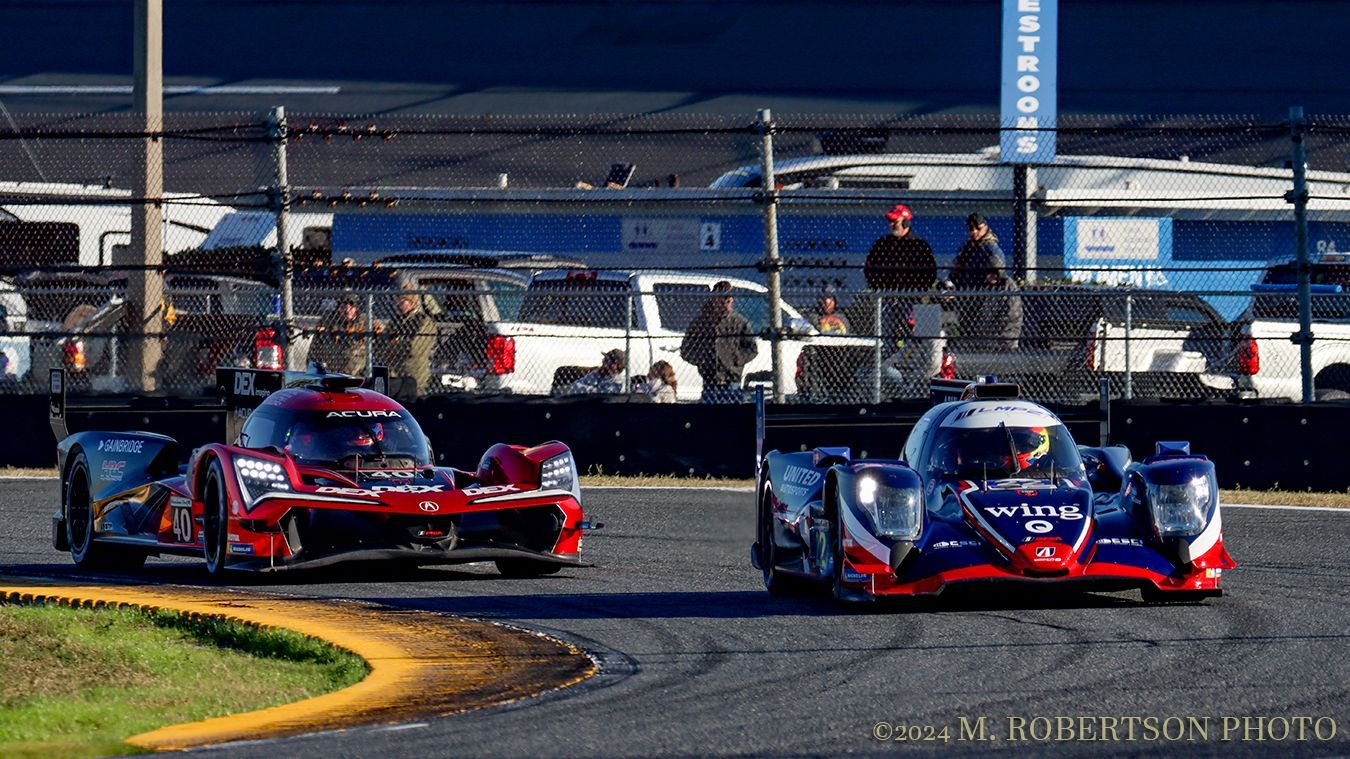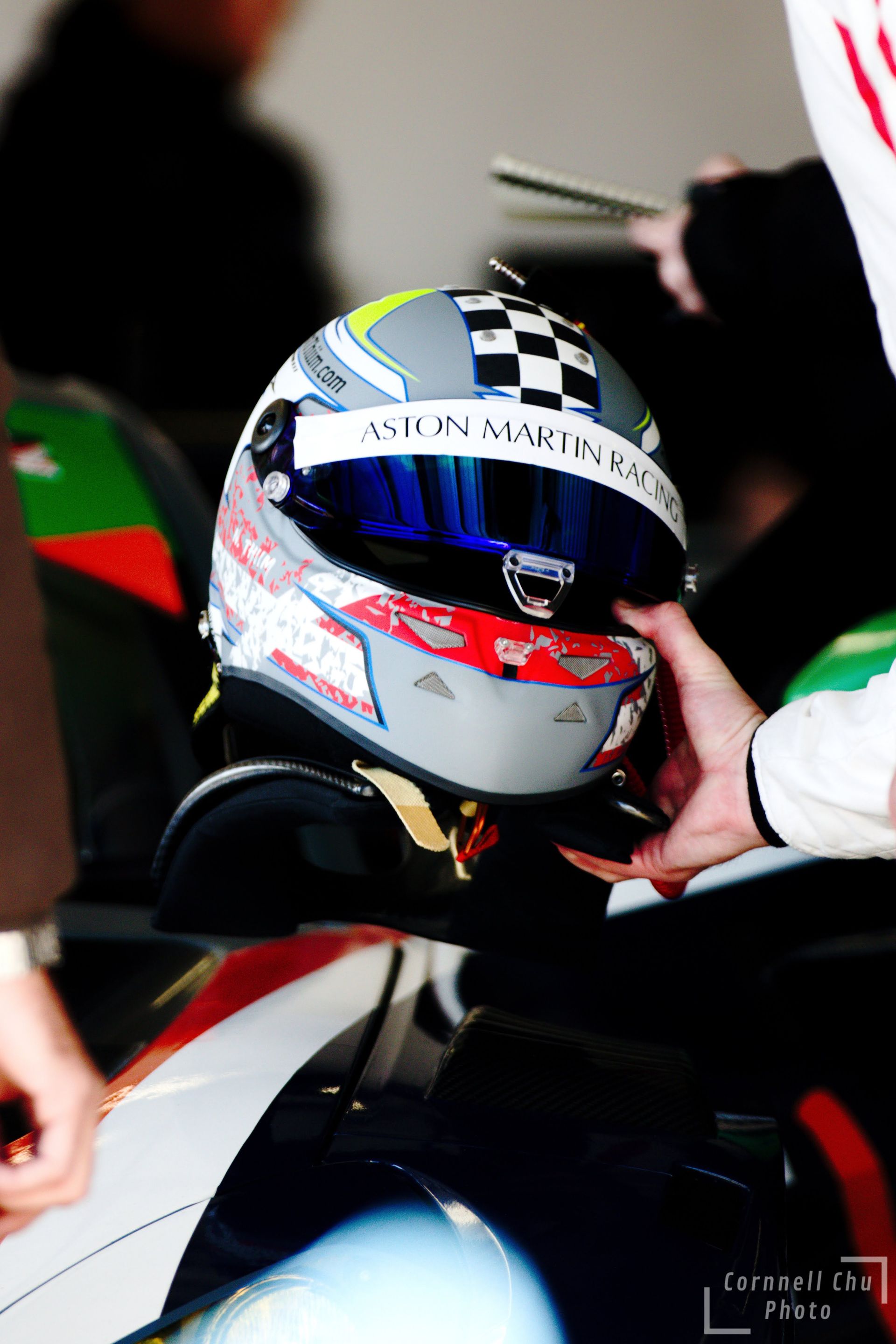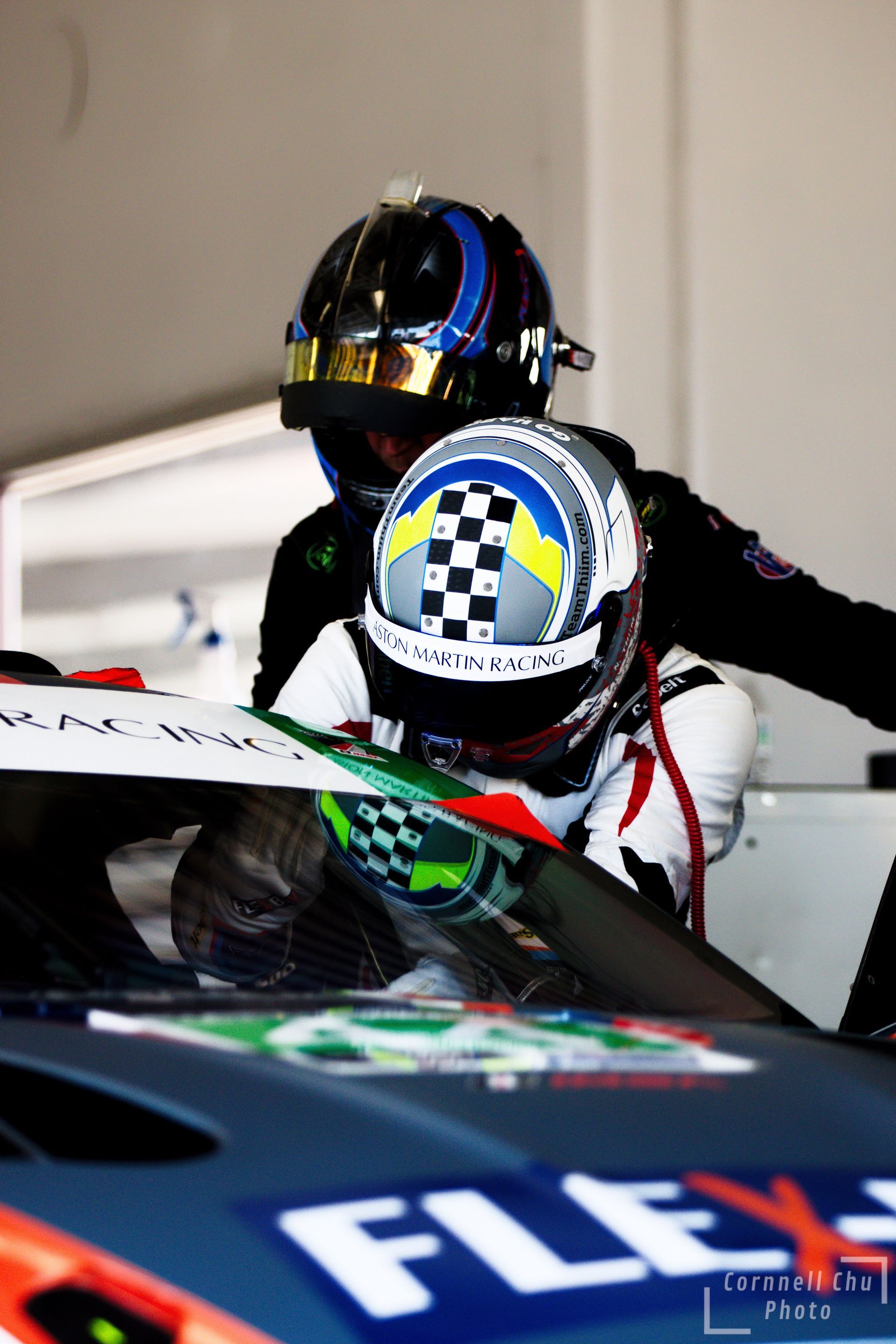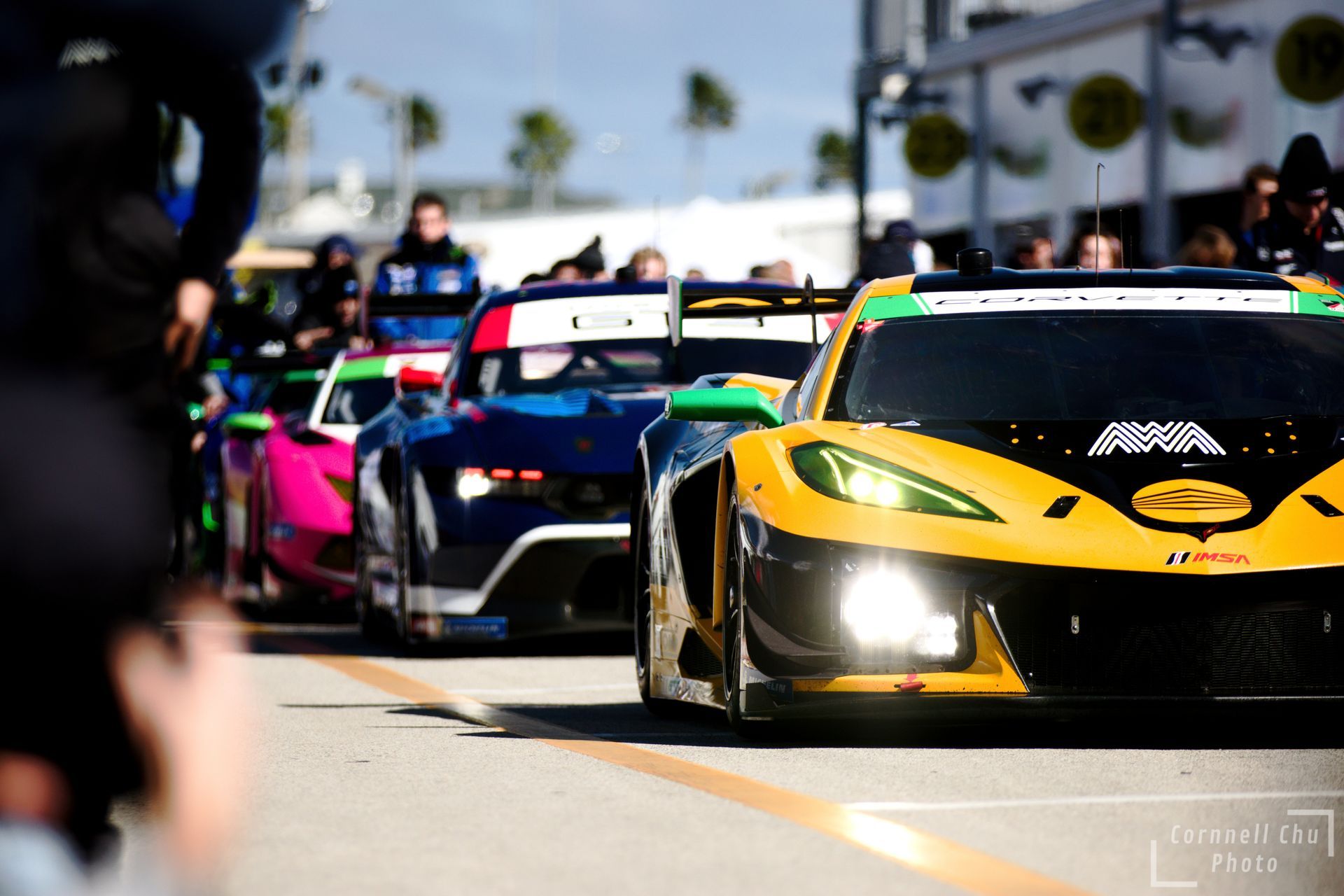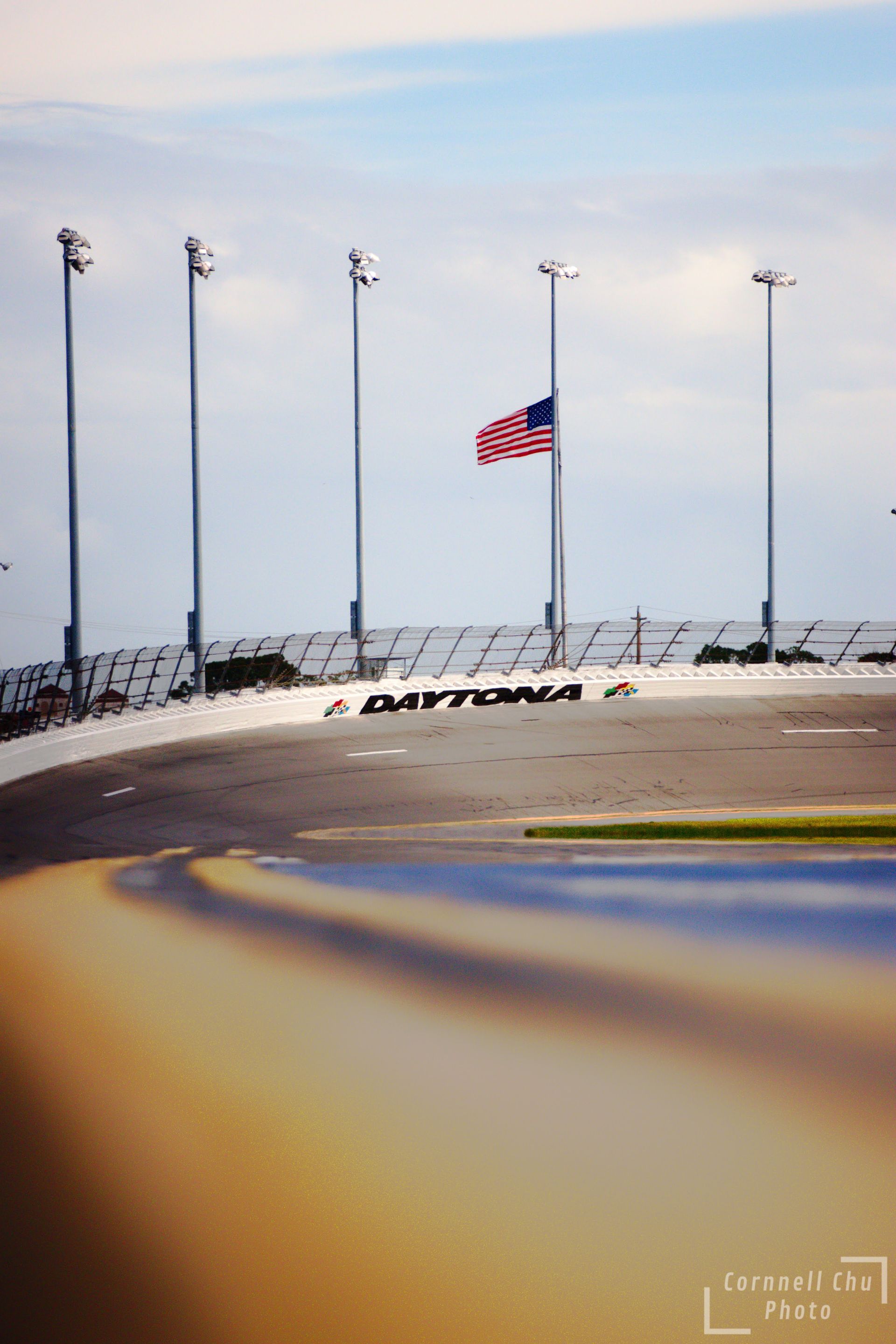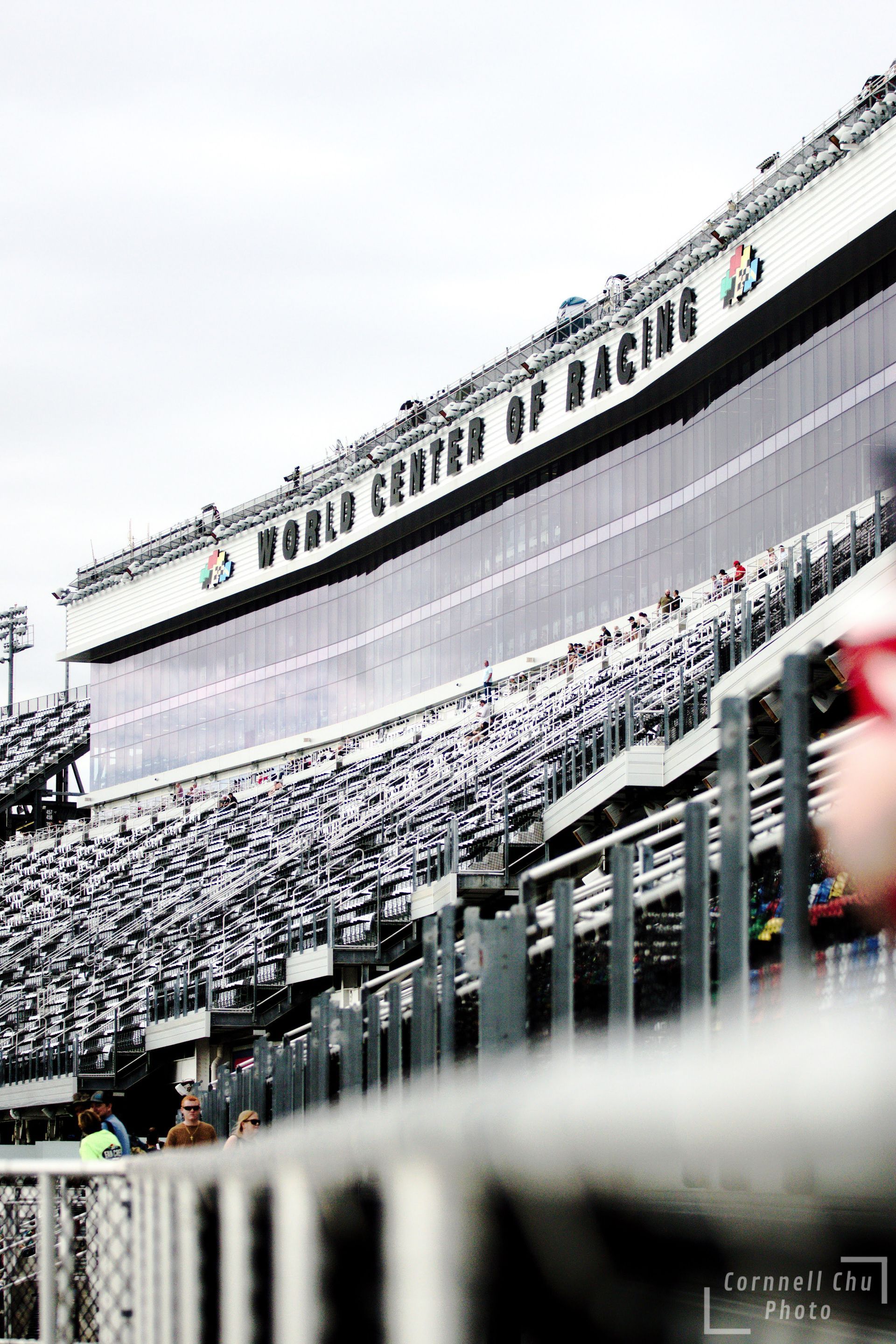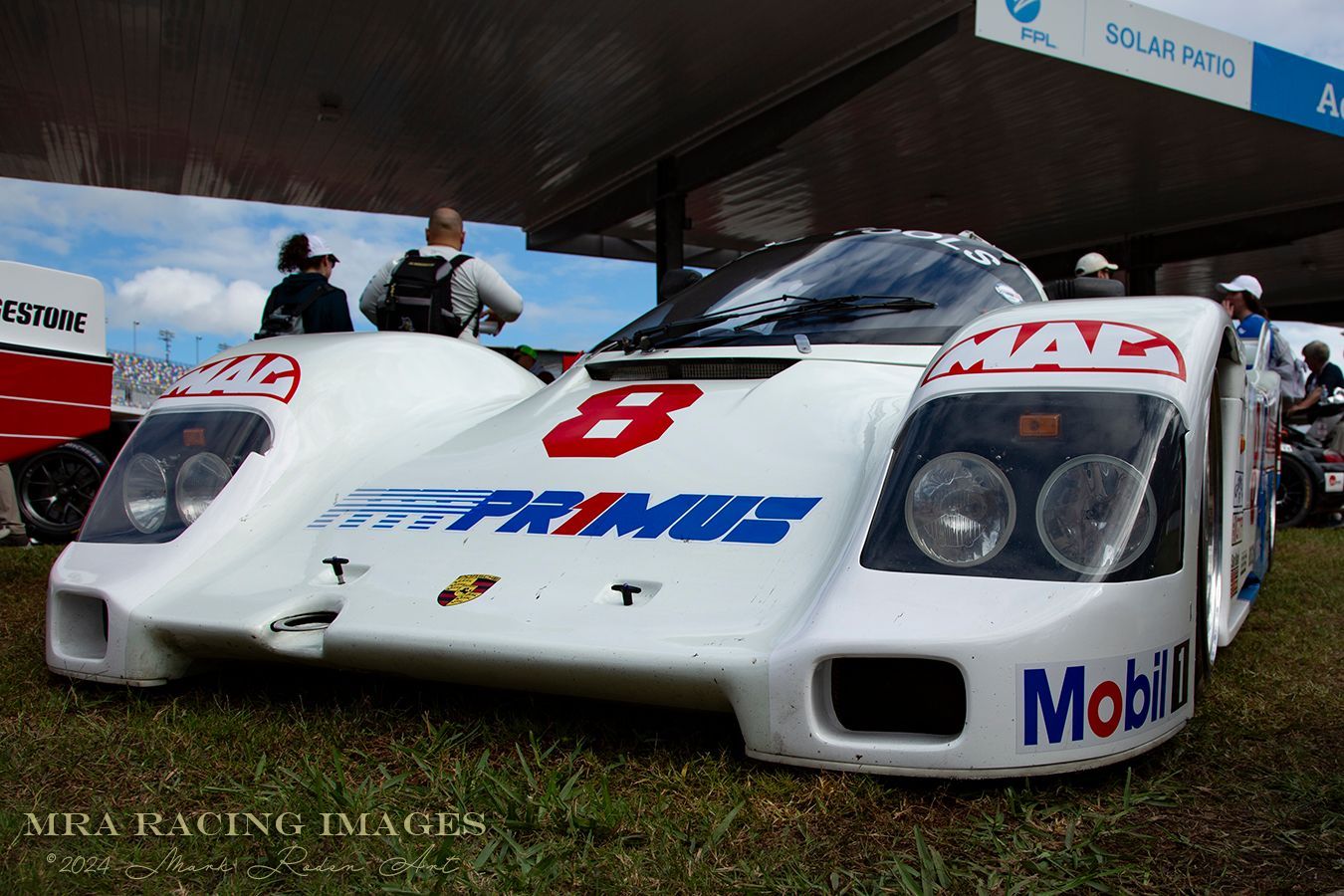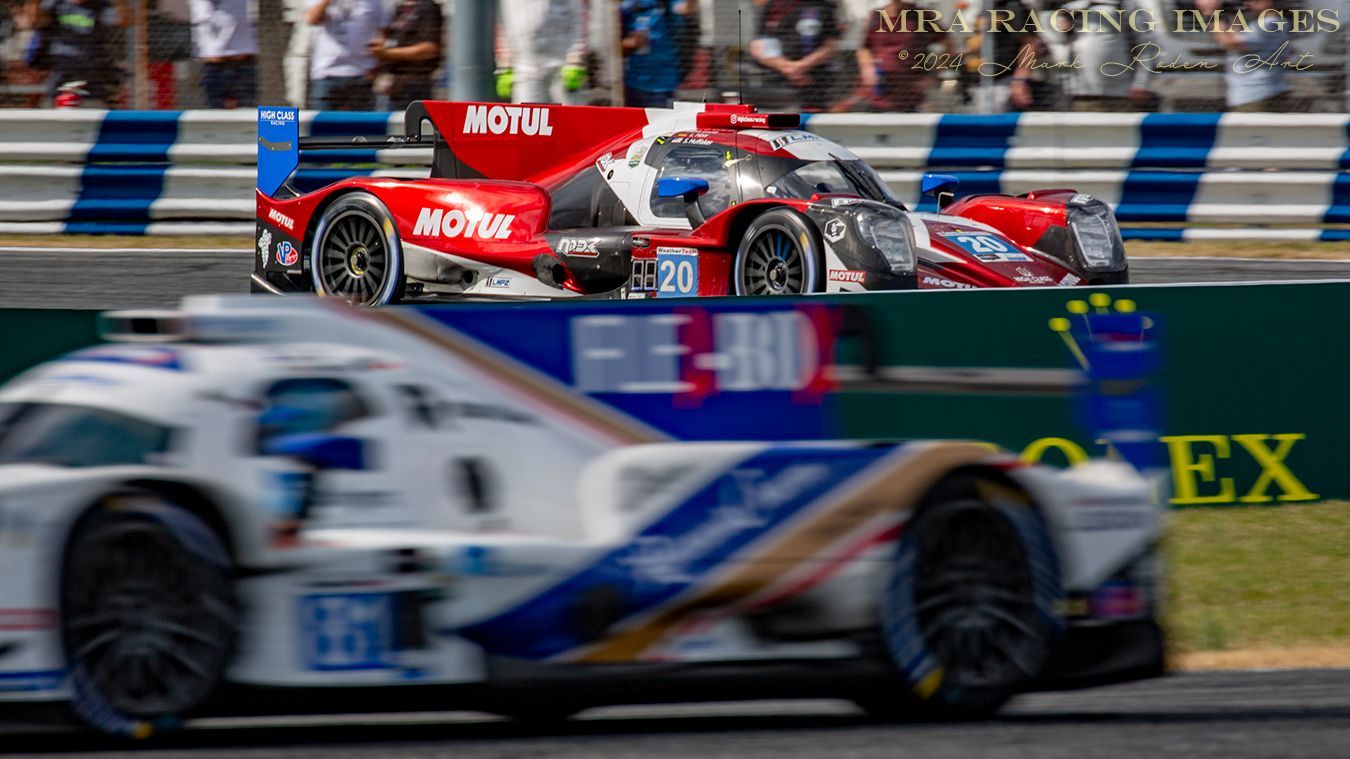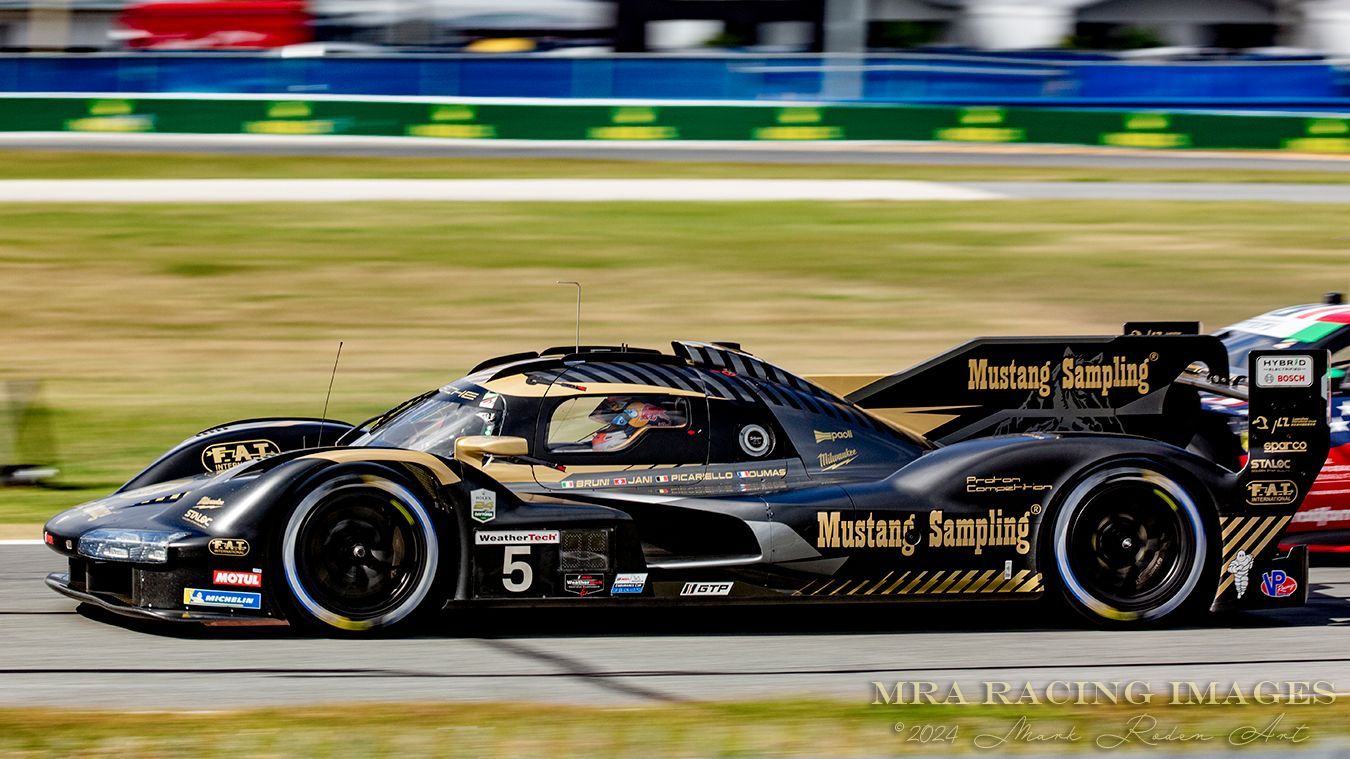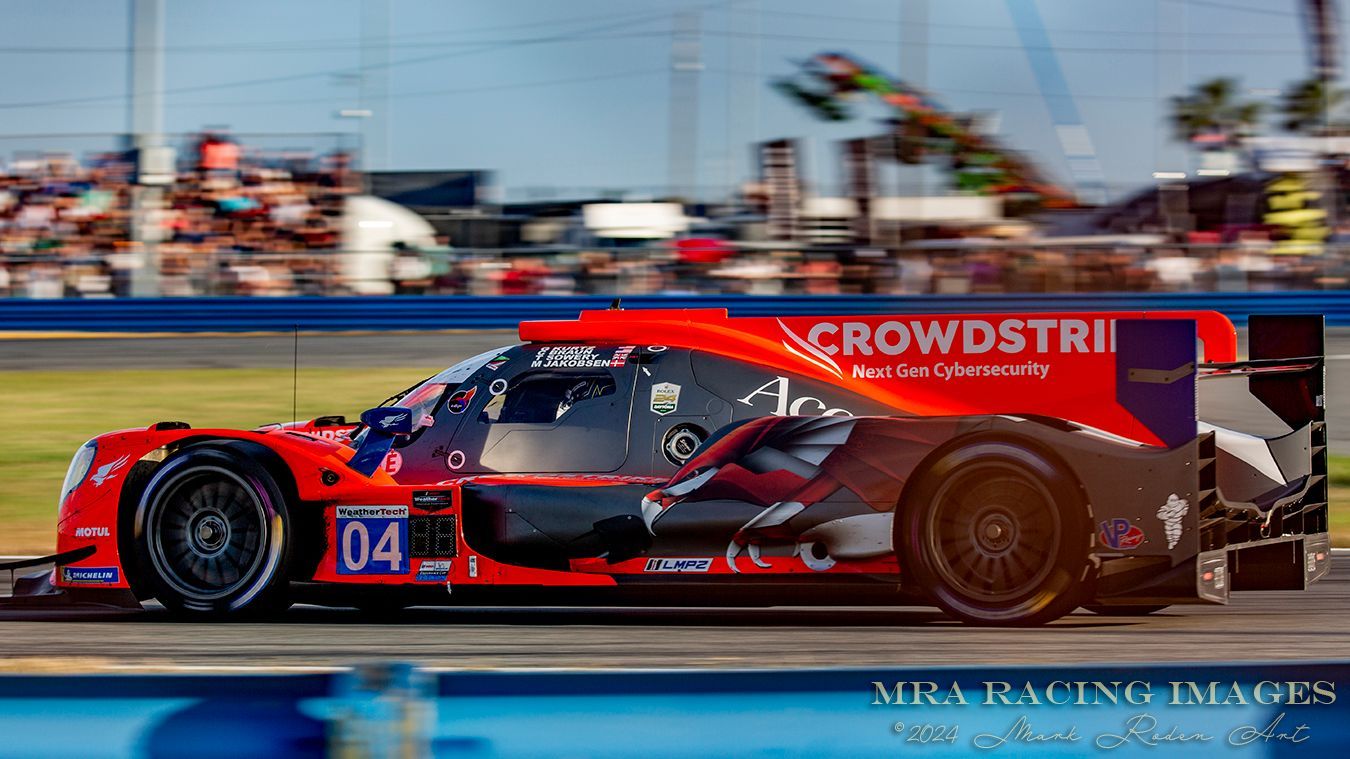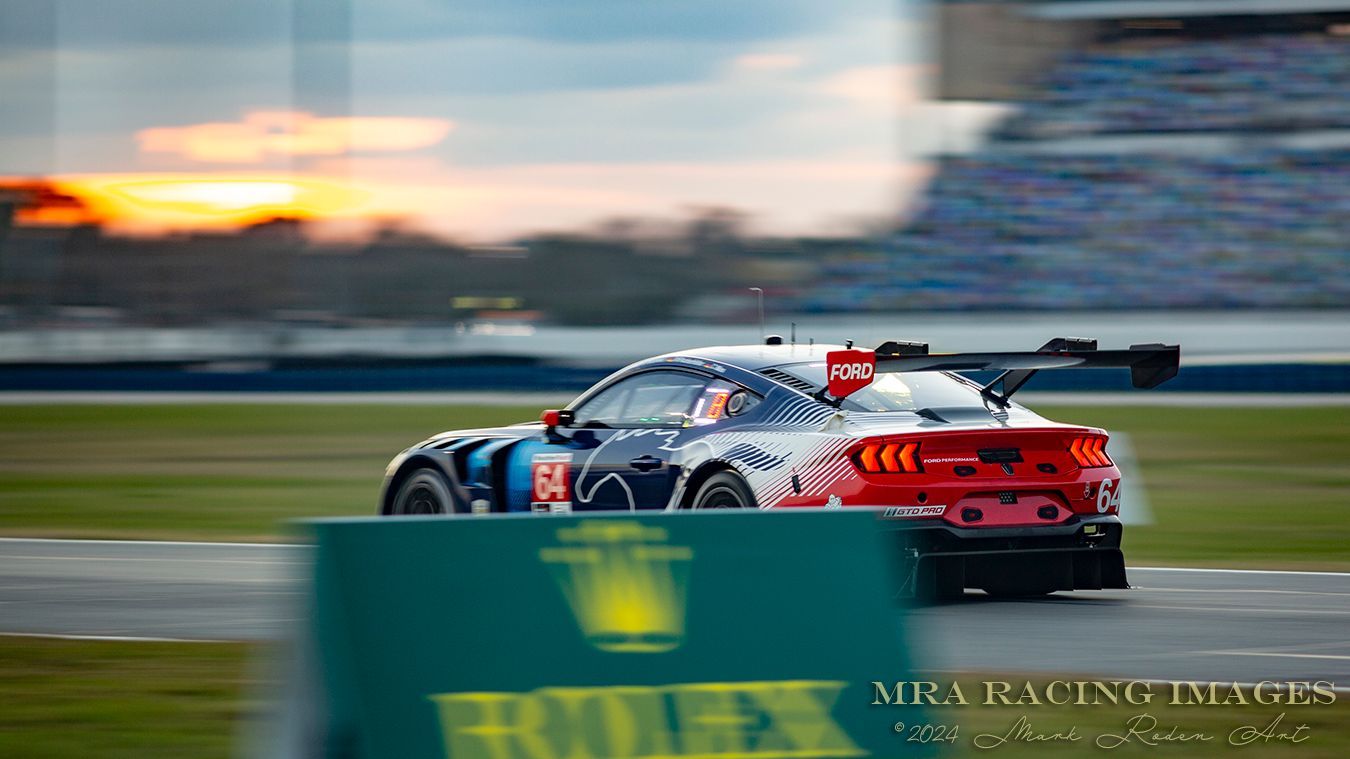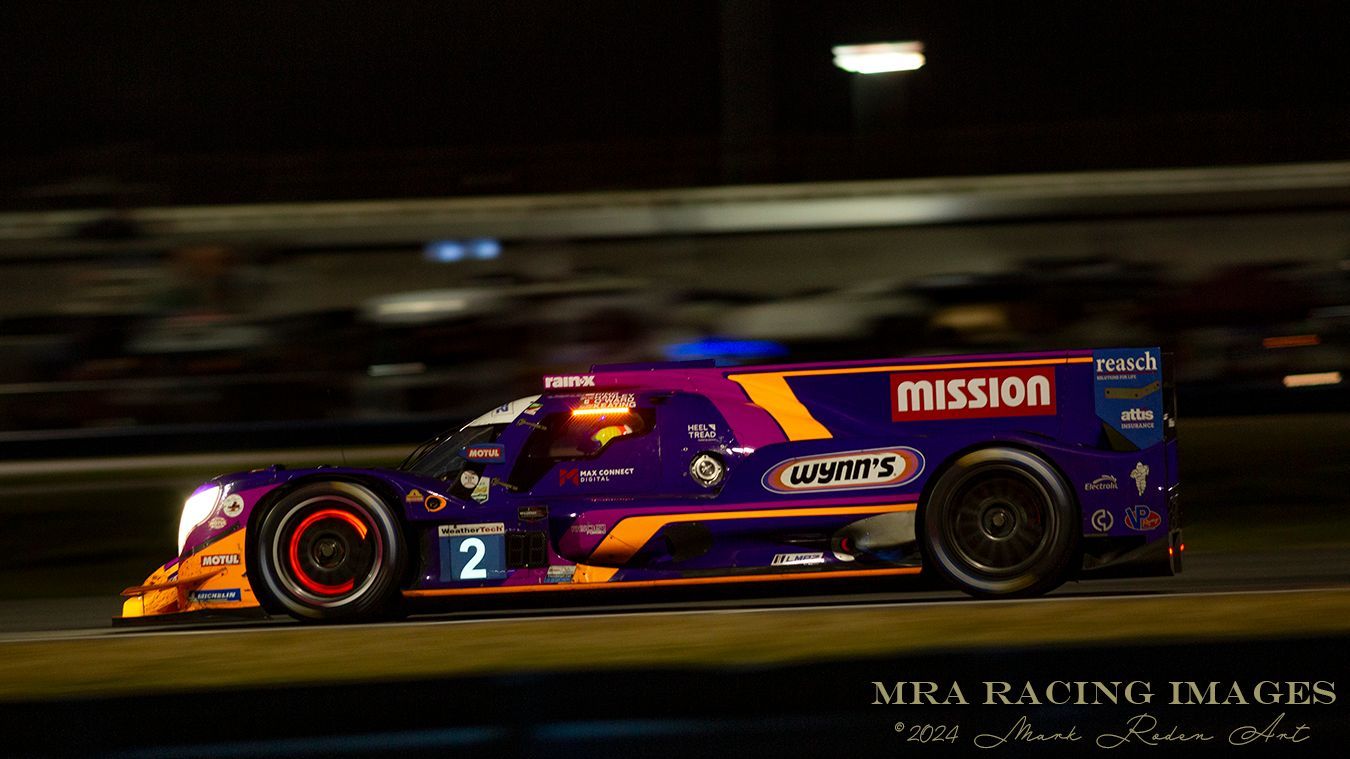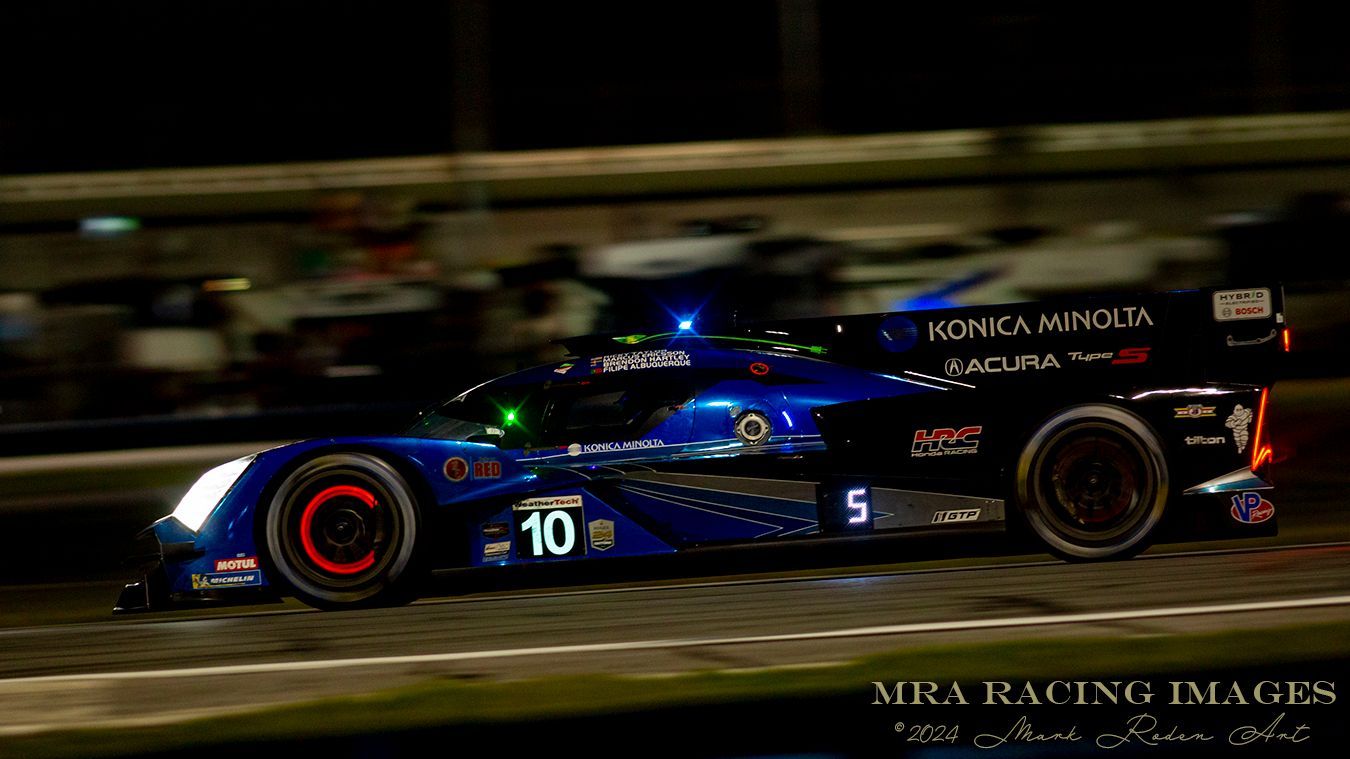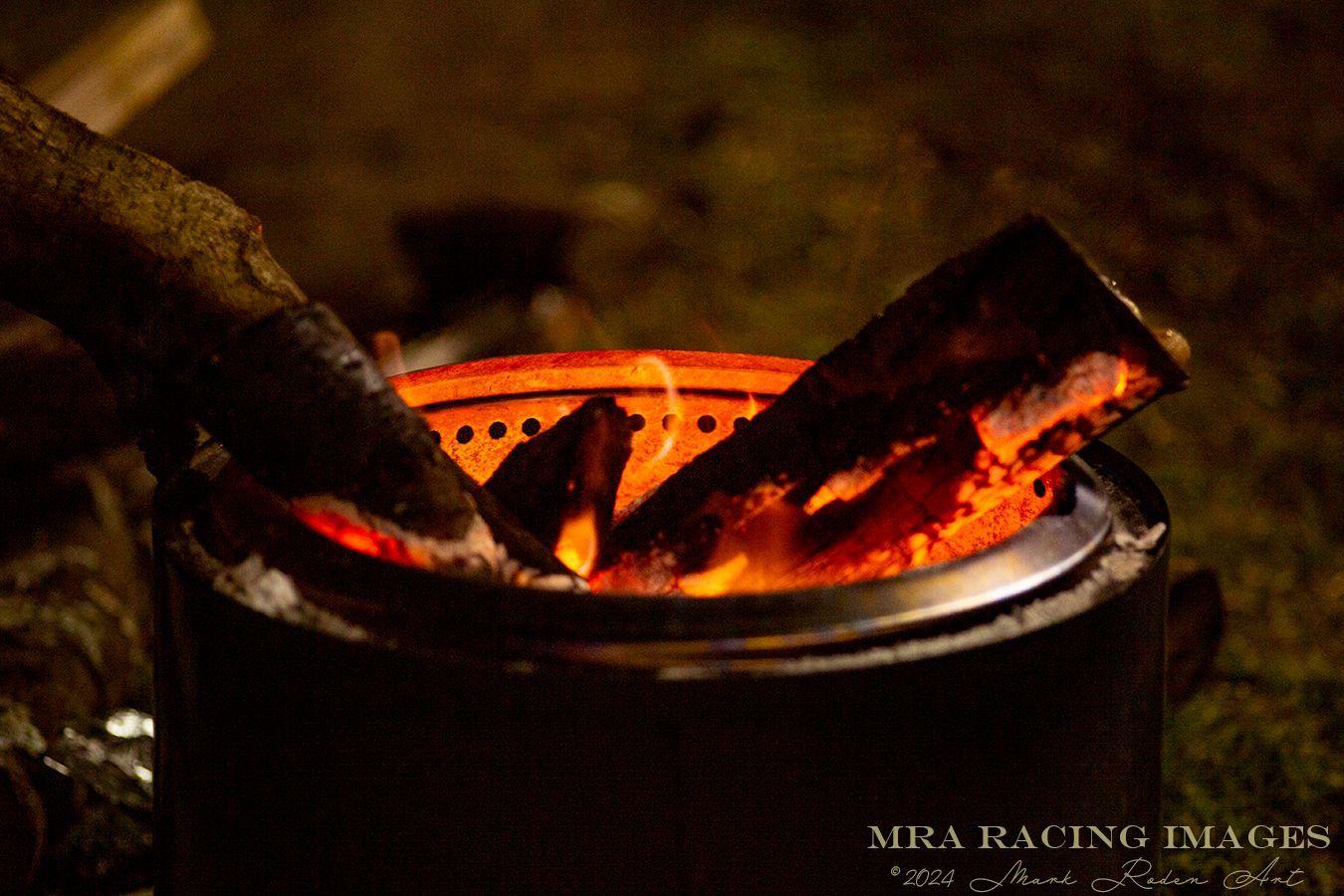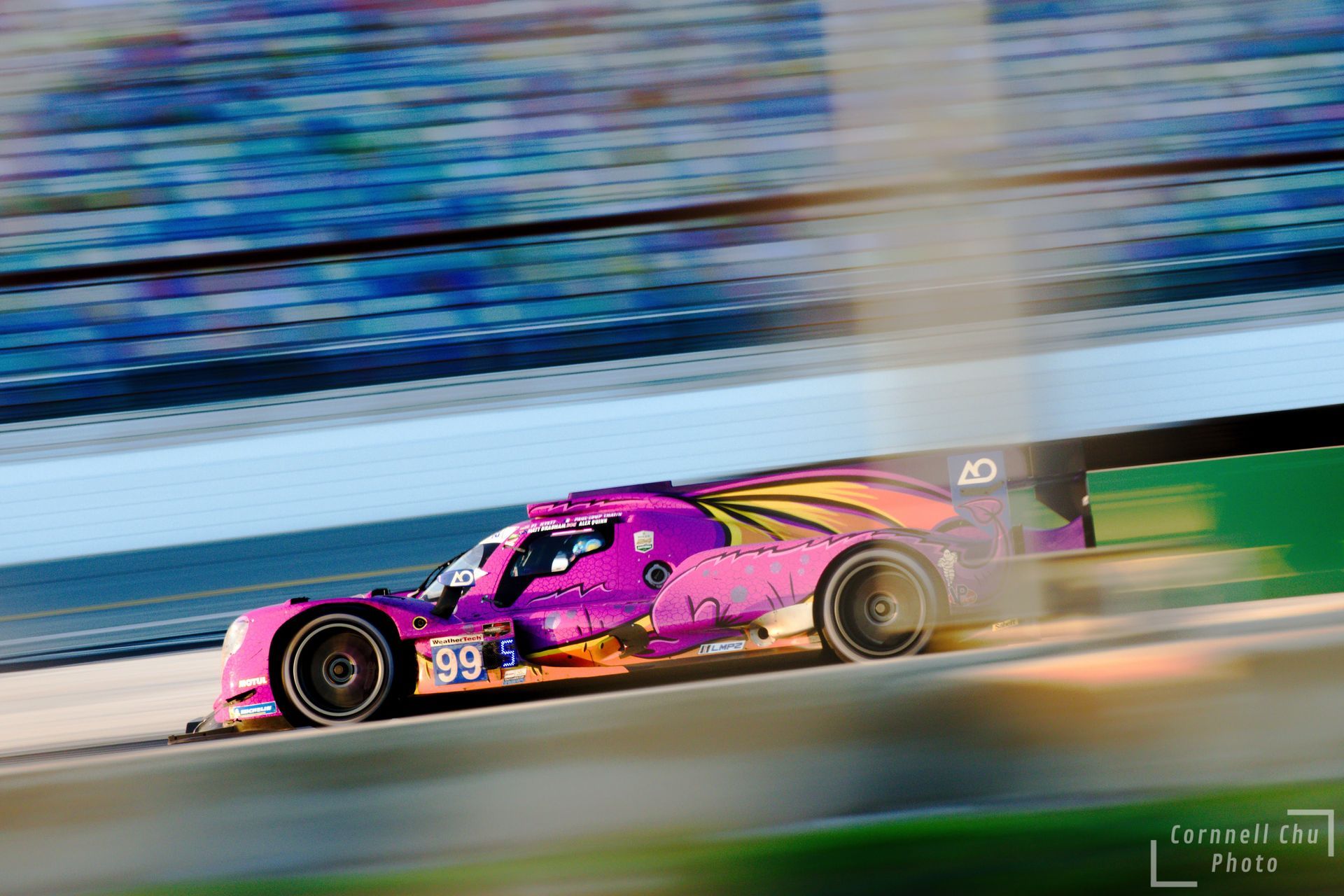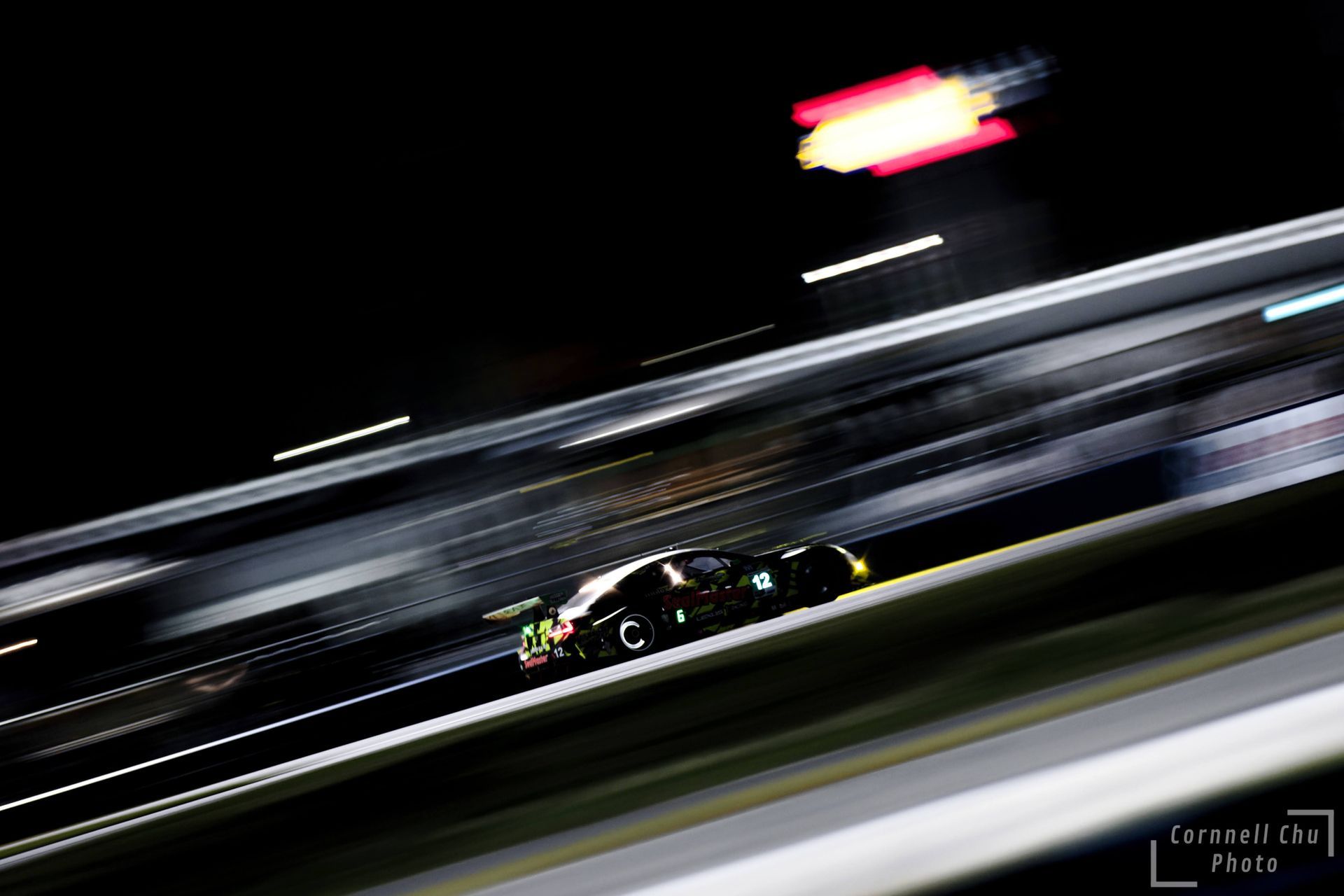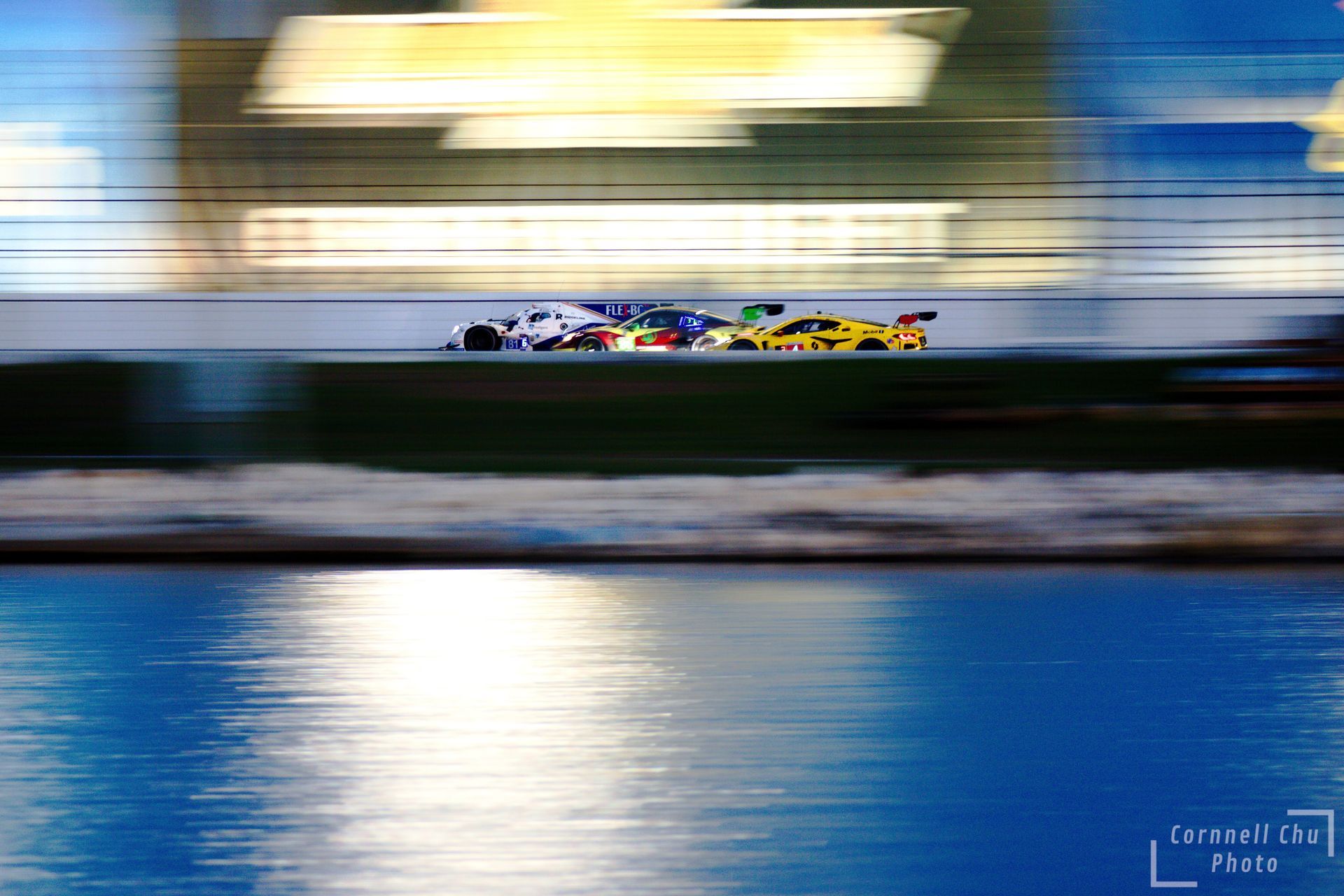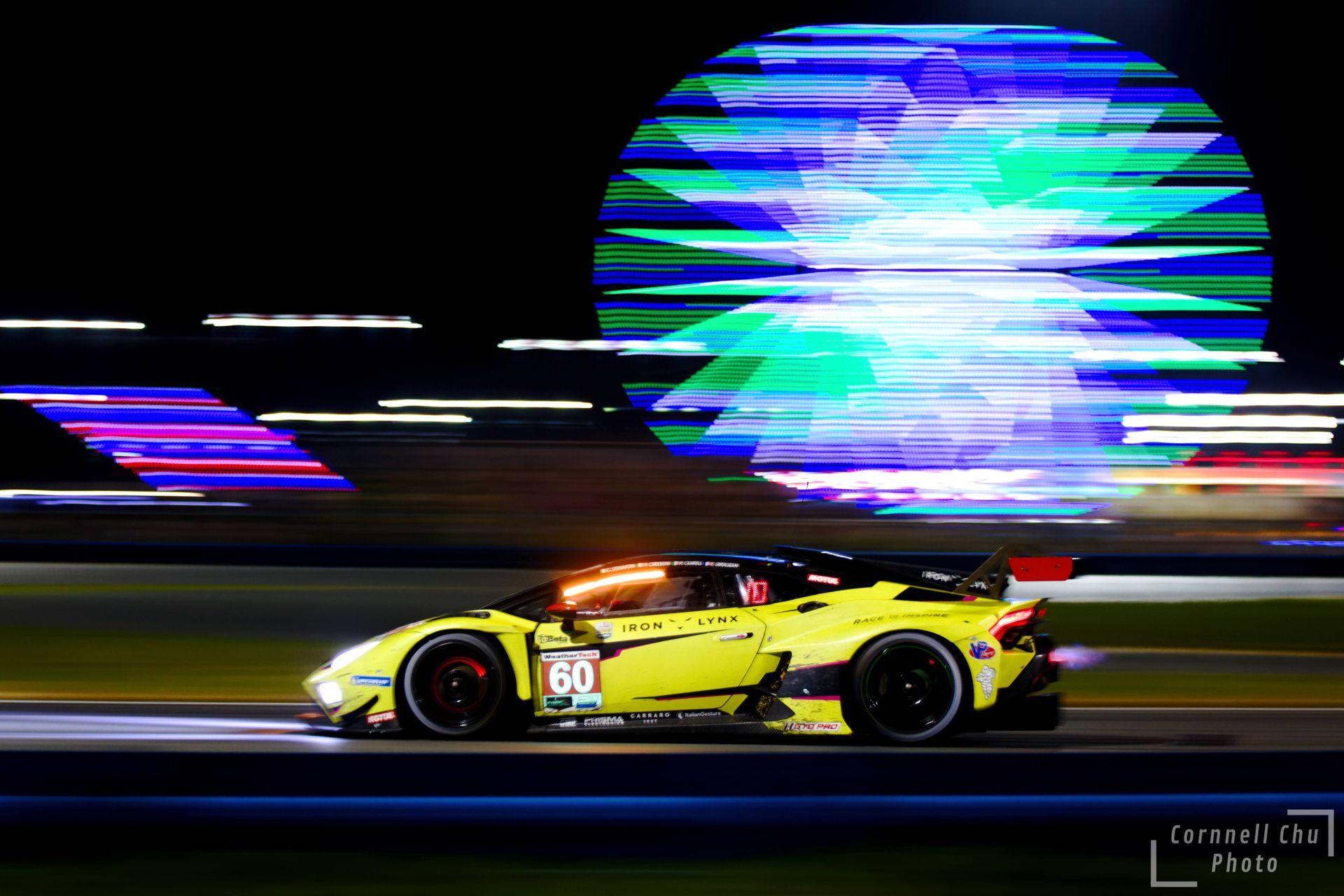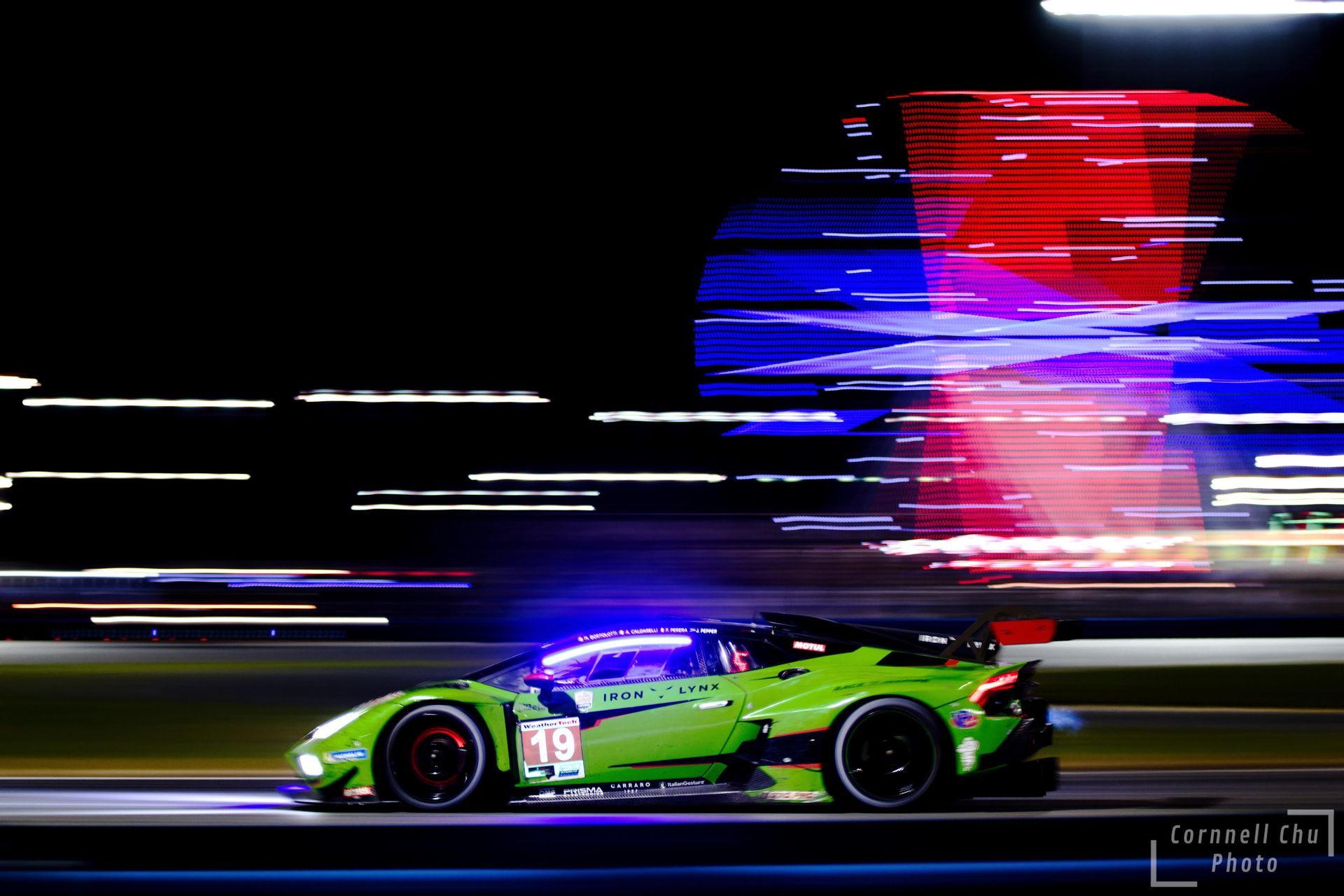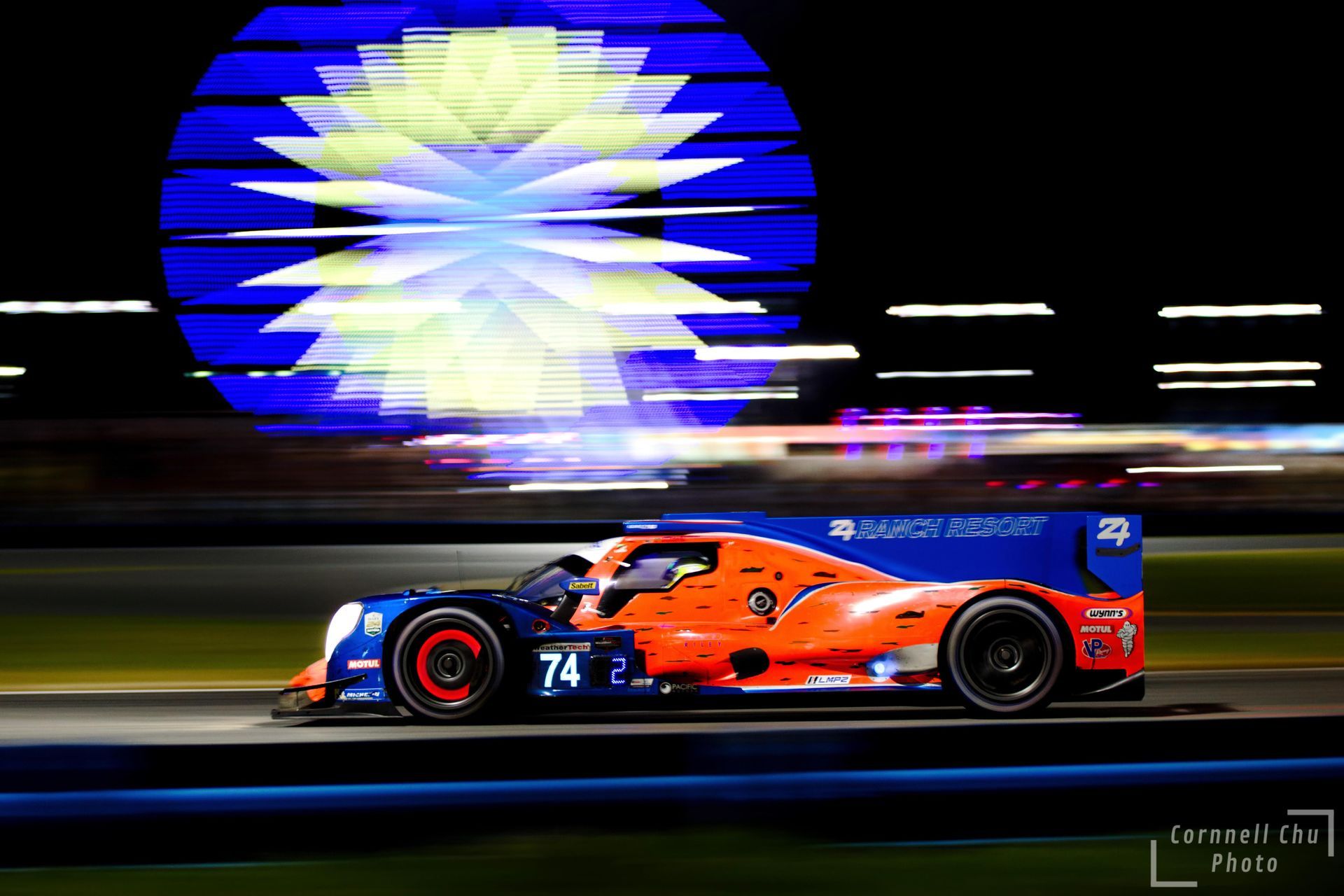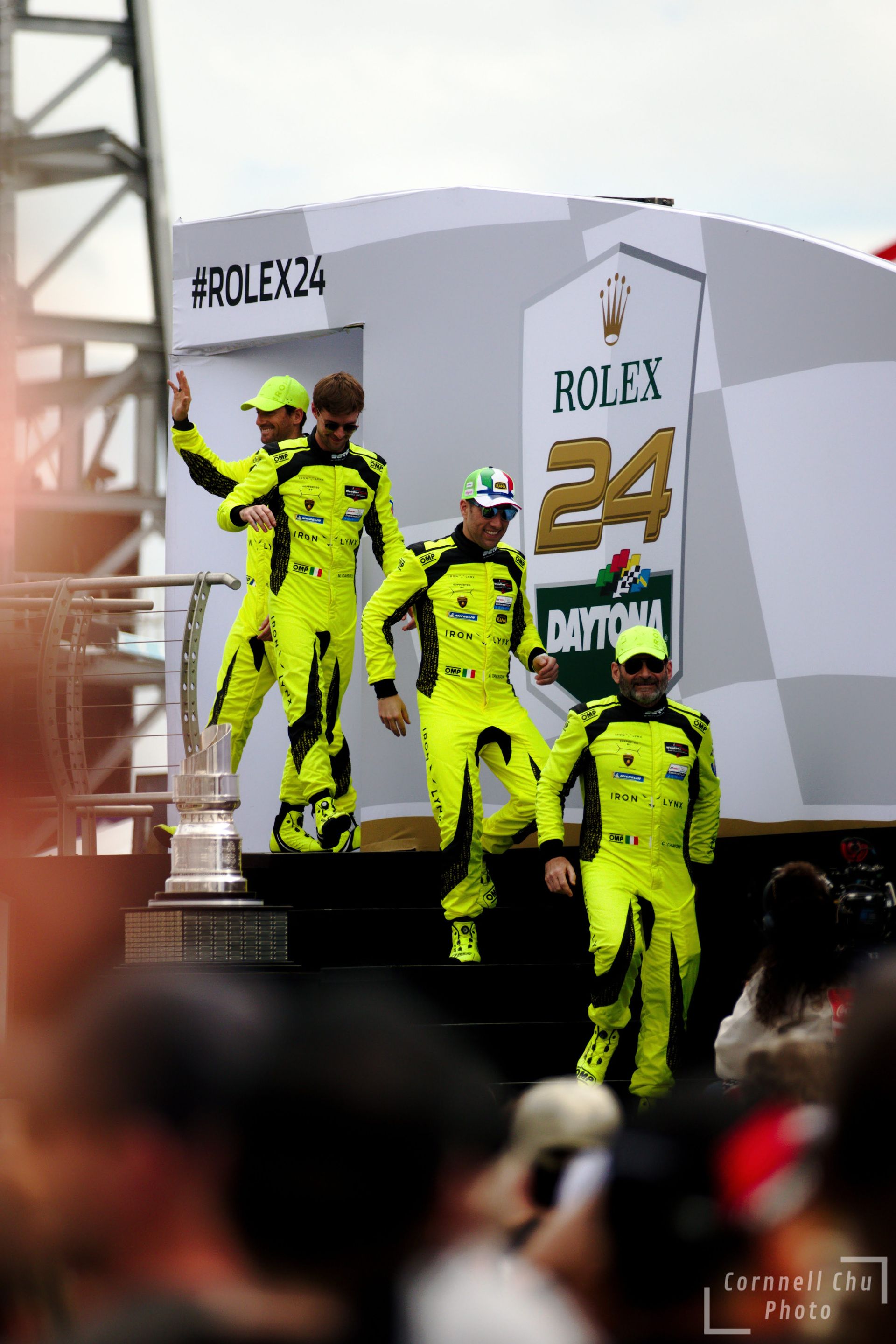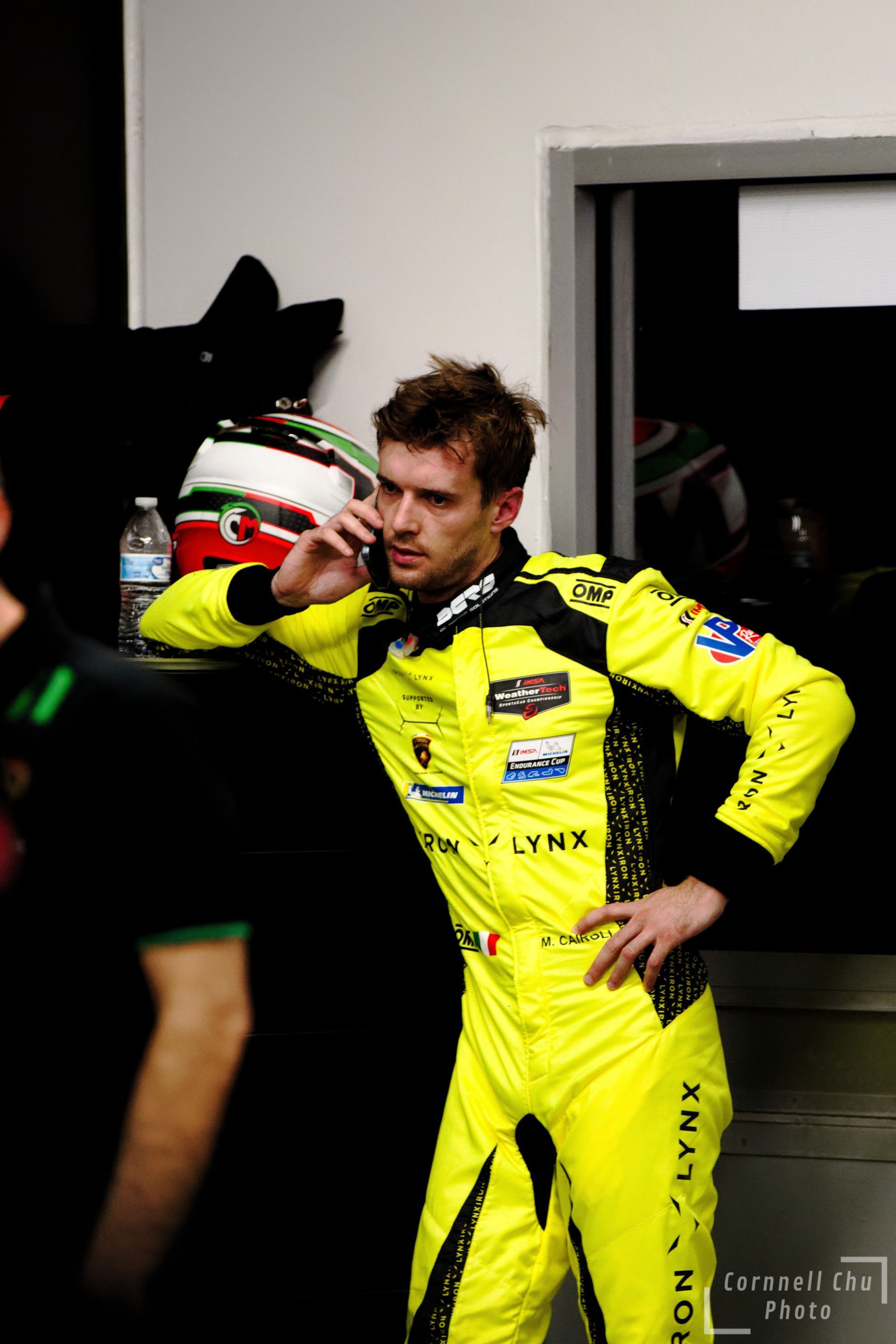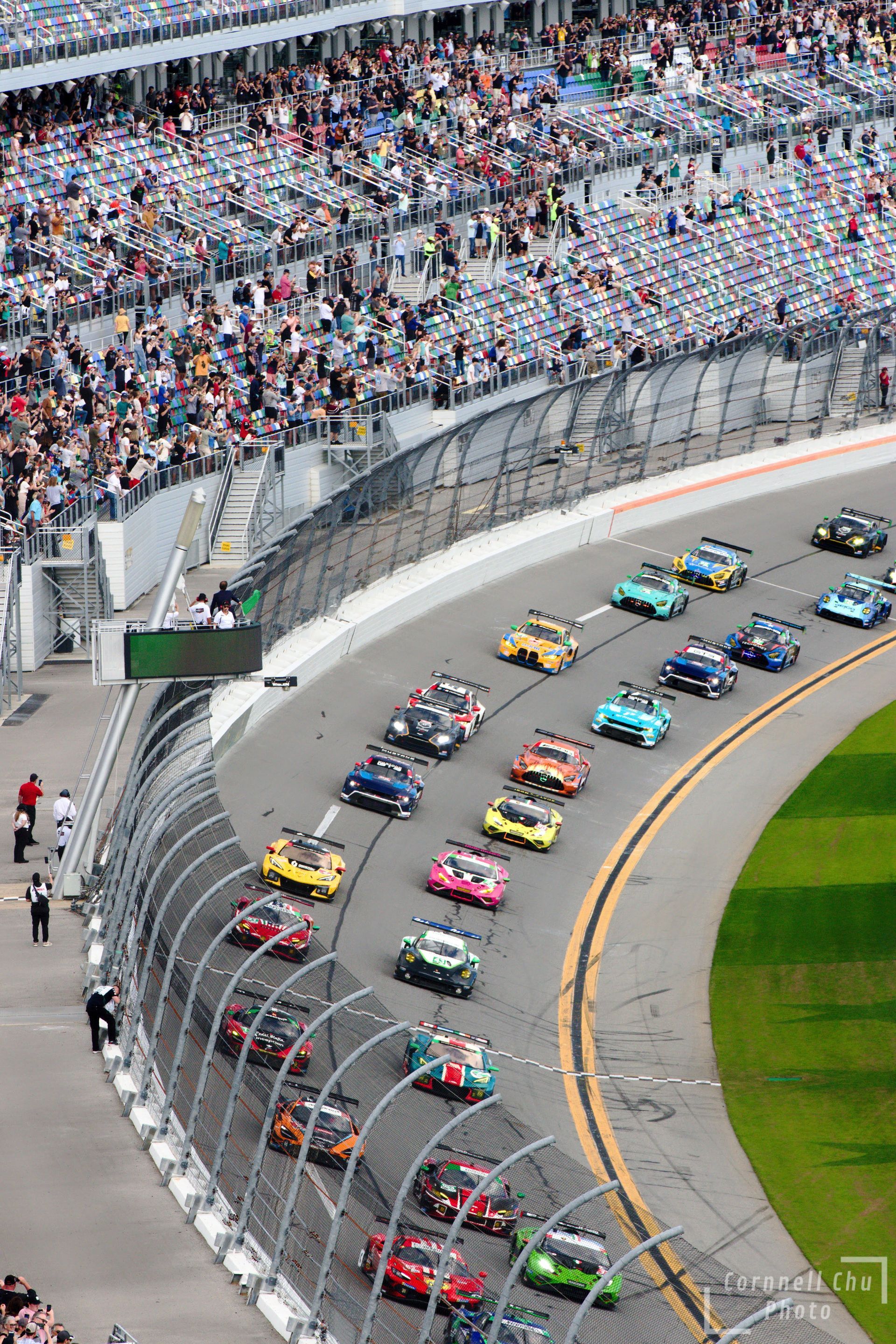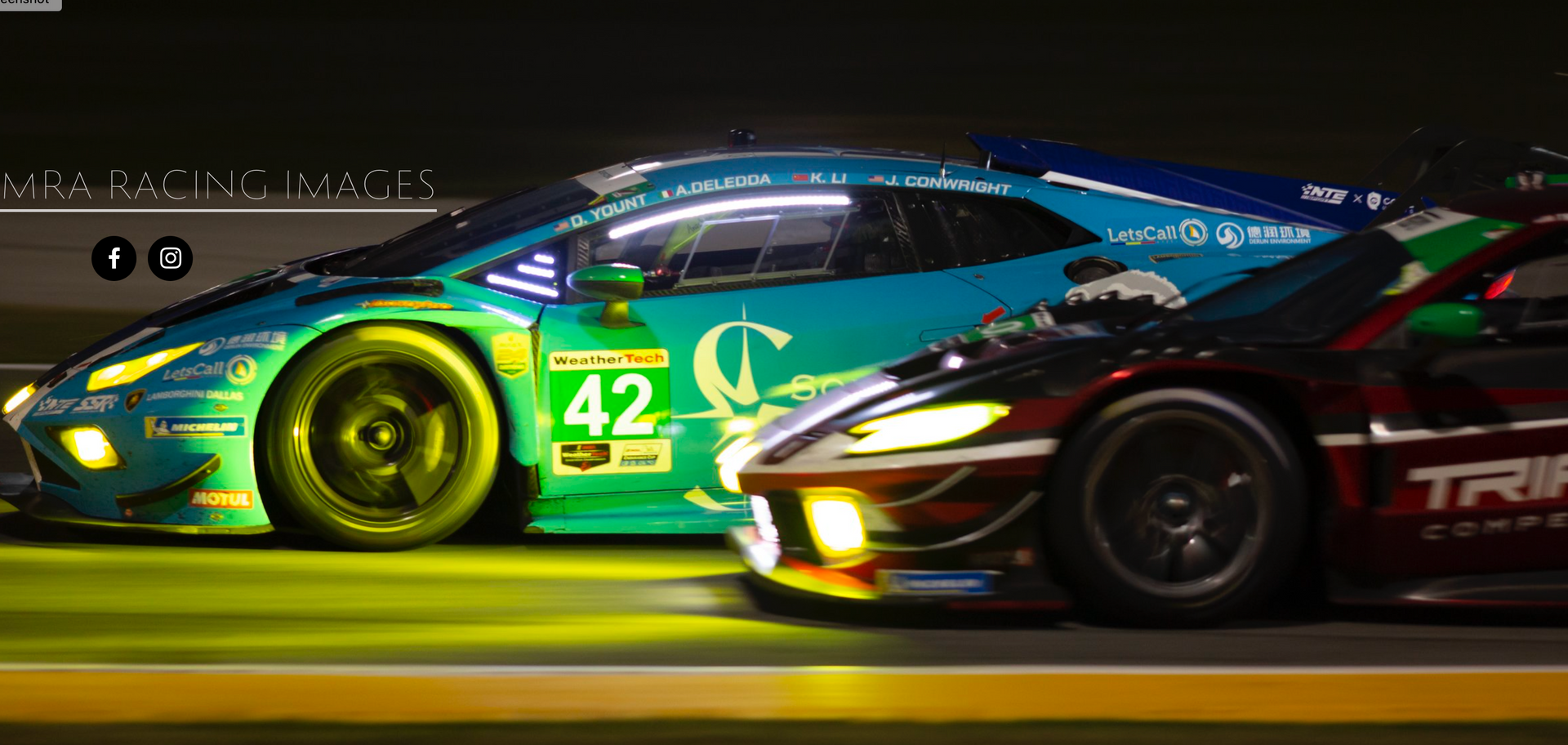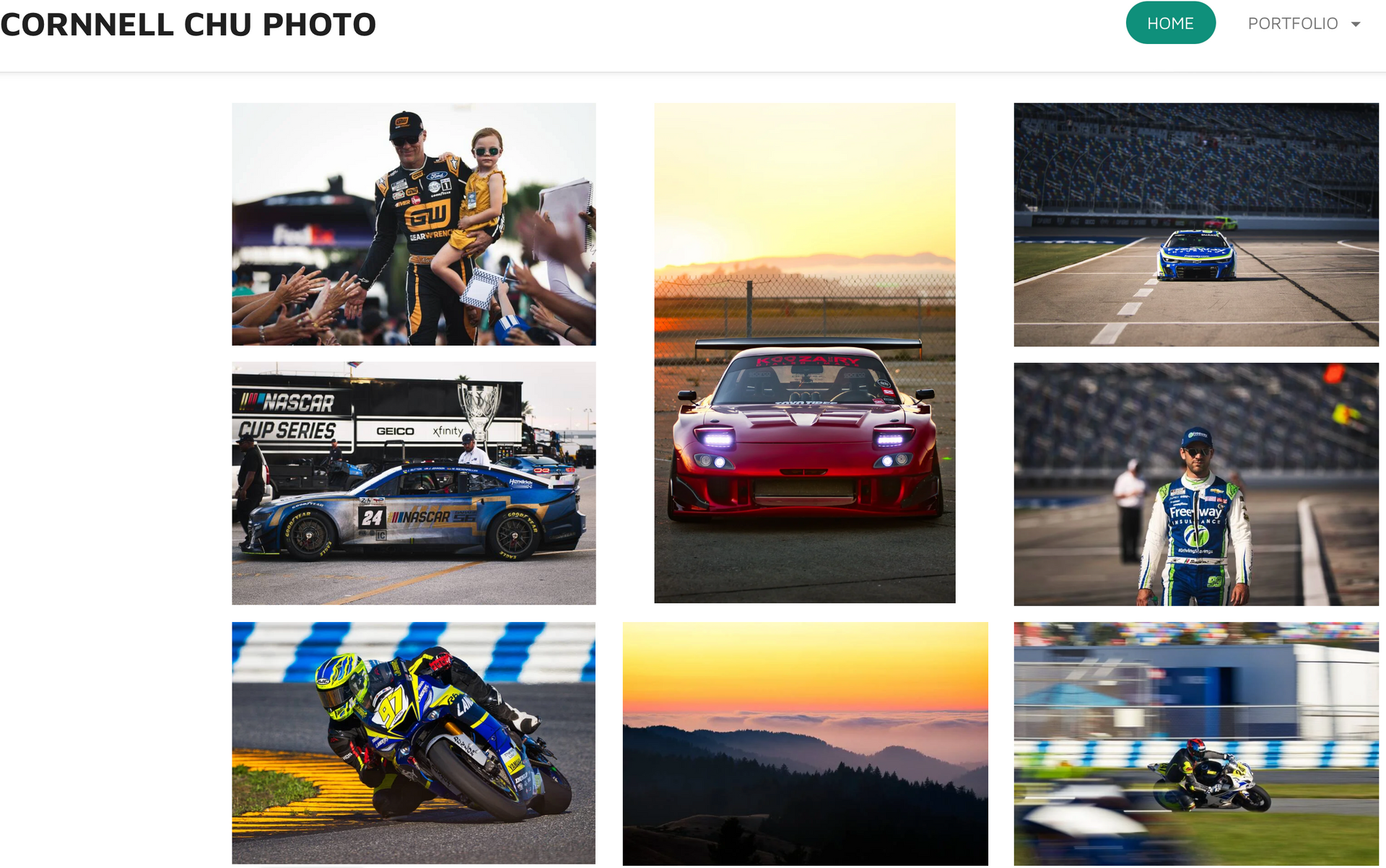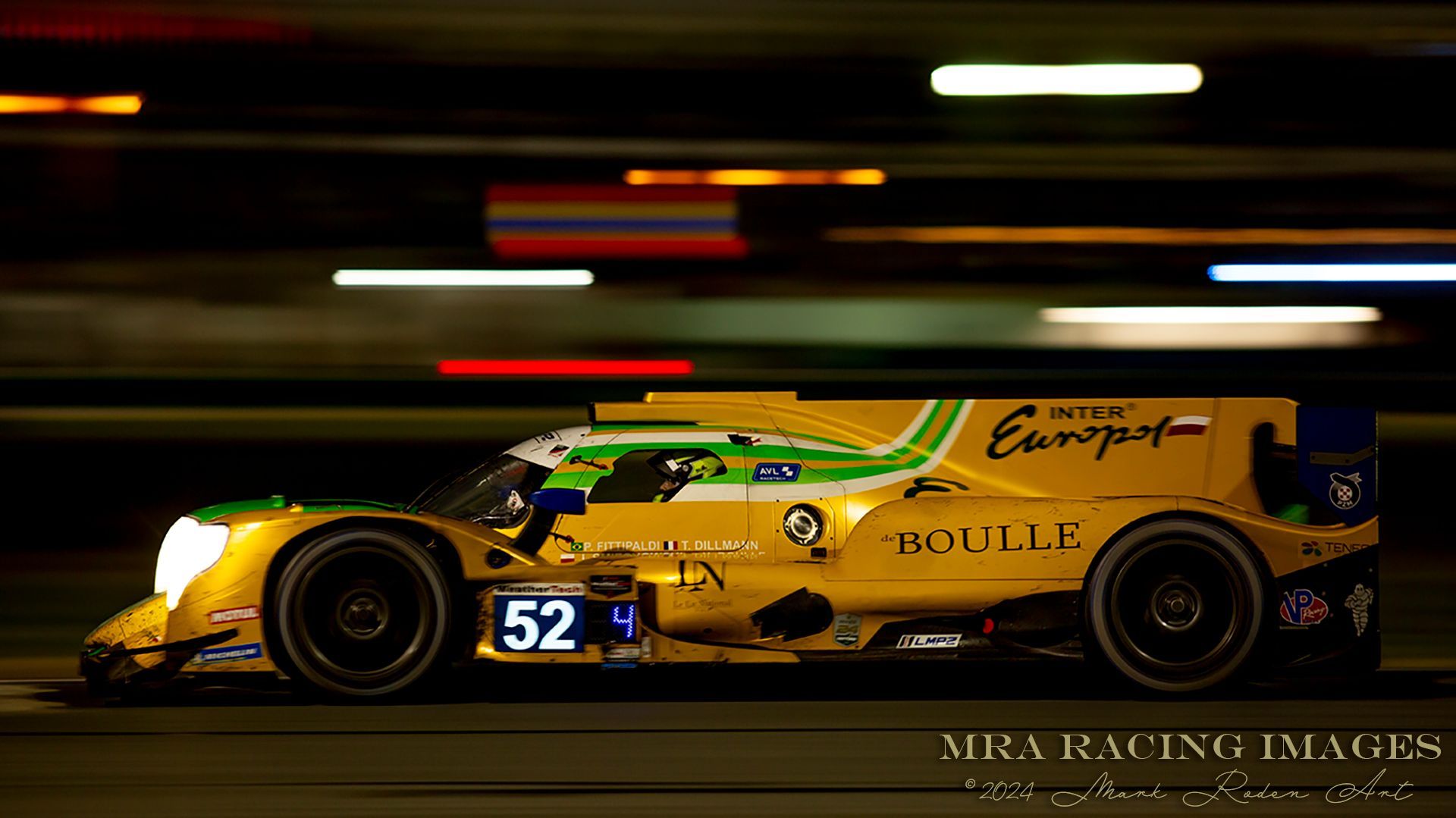
Rolex 24 Hours of Daytona 27th - 28 January 2024
A Trackside Report written by Mark Roden and Cornell Chu
Photography by Cornell Chu, Mark Robertson, and Mark Roden
The 2024 racing season begins with the Rolex 24 Hours of Daytona, held each year in January at the Daytona International Speedway. This year’s 62nd Rolex was the second iteration of the famous race in the modern GTP era, as well as the second year the event hosted the VP Racing Sportscar Challenge, which included the LMP3 (P3) class, dropped from the Weathertech Championship at the end of the ’23 season.
ROAR Before the 24 Quick Overview
The “ROAR” Before the 24 was a weekend of practice sessions for the main event, the Weathertech Championship series, as well as for the support classes, including 2 races for the VP Challenge series.
The teams were busy setting up the cars before the first competition laps of the year. A 4-day testing session was held in December, during which 42 cars completed homologation testing and underwent a program for the new balance of performance (BOP) procedures to take effect at the beginning of the 2024 racing season.
These events led up to the Rolex 24 Hours of Daytona.
Practice Sessions and a Pair of VP Challenge Races to Start Things Off
The first day of ROAR began with action from the VP Racing Sportscar Challenge, the Michelin Pilot Challenge, and the Weathertech Championship, each cutting practice laps during their series’ FP1 and FP2 sessions on Friday.
The VP Challenge is now in its second year and boasts a field of 32 entries in two classes. The P3 class, which ran with the Weathertech Championship in 2023 as LMP3, is now a part of the VP Challenge, sporting 9 Ligier P320’s and a single Duqueine D-08. The GSX class contains a mix of Aston martin, BMW, Ford, McLaren, Mercedes-AMG, Porsche, and Toyota entries.
Steve Aghakhani, who was in his first race in LMP3 after taking a year off from driving in the Lamborghini Super Trofeo North America series, won the race on Saturday from the pole in the #6 MLT Motorsports Ligier JS P320, even though he spent most of the race in second place, winning it with just 2 minutes to go. On Sunday, Aghakhani repeated his win by taking the VP Challenge P3 race 2.
Luca Mars piloted the new Ford Mustang GT4 for its first competition laps on track, winning the Grand Sport X (GSX) class from a starting position at the back of the grid, taking the checkered by only .051 seconds. He repeated his win on Sunday in GSX in Race 2.
Turner Motorsports will be defending their 2023 Michelin Pilot Challenge Grand Sport (GS) class championship win with drivers Robert Megennis and Dillon Machavern in the #95, and Robby Foley and Francis Selldorff in the #96. Both are BMW M4 GT4’s, and the drivers boast a very nice record.
Foley was the 2023 Michelin Pilot co-champion. Selldorff was the 2023 VP Racing Sportscar Challenge GSX class champion. All 4 drivers and the Turner Motorsports team are prepared to kick off another stellar season.
In their second year as the premiere class, the IMSA GTP cars have made quite a showing and continue to improve in speed and appearance. The official entry list has ten GTP entries, one of which is a second Acura for the Wayne Taylor Racing with Andretti Autosport team, the #40 Acura ARX-06 piloted by Louis Deletraz, Colton Herta, Jenson Button and Jordan Taylor.
The Whelen Cadillac Racing V-LMDh entry was consistently at or near the top during most of the ROAR, taking the top spot in qualifying. Pipo Derani and Jack Aitken are joined this year by Tom Blomqvist, coming from the Meyer Shank Racing team which will not be competing this year, electing instead to concentrate on their NTT Indycar Series efforts.
Overall, the GTP grid looked strong, with 9 of the 10 entries qualifying within a second of each other. Only the Proton Competition Porsche was absent from qualifying due to an earlier incident which prevented their run.
In the LMP2 class, several notably strong entries filled the top qualifying spots. The #2 United Autosports USA team with drivers Hanley / O’ Ward / Keating / Pino took the top spot. The team sports quite the racing pedigree:
--Ben Hanley has won this race in 2020, was part of the winning LMP2 team for the 2021 24 Hours of Le Mans and won the 2022 Asian Le Mans series championship.
--Patricio “Pato” O’Ward has had a budding career so far in Indycar, driving for Arrow McLaren SP since 2020 as well as having experience in other series including the Weathertech Sportscar Championship. In 2017 he was on the team to win both the 24 Hours of Daytona race and the 12 Hours of Sebring, becoming the youngest driver to win both races.
--Ben Keating has participated in several series including the Rolex Sports Car Series, the American Le Mans Series, and the Weathertech Sports Car Championship since 2014. He has won the 24 Hours of Le Mans, 12 Hours of Sebring multiple times along with several wins at other tracks. He has been on the teams winning the IMSA Sportscar Championship in LMP2 class and the FIA World Endurance Championship (twice each).
--Nico Pino is an up and coming young driver (19 yo) who has scored 4 wins in the European Le Mans Series including the Monza Circuit and the Circuit de Spa-Francorchamps.
The second qualifying spot went to the Inter Europol by PR1/Mathiasen Motorsports team with drivers Jakub “Kuba” Smiechowski / Nicholas Boulle / Tom Dillman / Clement Novalak.
The team is a partnership between Inter Europol Competition, which won last year’s 24 Hours of Le Mans in the LMP2 class in convincing fashion, and PR1/Mathiasen Motorsports, which won the team championship in the Weathertech series for LMP2 in 2023.
The two teams have come together to participate in the full 2024 schedule of the IMSA Weathertech Sportscar Championship.
Sitting in position 3 on the grid is the Crowdstrike Racing by APR team of George Kurtz / Colin Braun / Toby Sowery / Malthe Jakobsen. The team would like to improve upon its prior year finish of P2, missing the win by .016 seconds, making it the closest finish in the history of the race.
4th qualifying position went to the #74 Riley Motorsports entry of Gar Robinson / Felipe Fraga / Josh Burdon / Felipe Massa, just .045 seconds behind 3rd and .796 seconds behind the top spot.
I began photographing on the first day of the ROAR outside turn 3, also known as the “Horseshoe”, where I managed to catch up with Cornell Chu, another PistonClick photographer.
The weather was overcast for most of the afternoon which taxes my 400mm a bit, however I do like it from the standpoint of the even lighting. I tried to use a polarizer but there just wasn’t enough direct light to use it properly so back in the bag it went.
I arrived mid-afternoon during the Michelin Pilot Challenge P2 practice session. I have found this series to be quite fun to watch and exciting to photograph, as there is a good variety of manufacturers and liveries to satisfy the palette.
As the Weathertech series began its last practice of the day, I noticed the Crowdstrike car seemed to have a brighter shade of red (or was it…orange?) than last year. The LMP2 entry looked great on track, and the team of Kurtz, Braun, Sowery and Jakobsen appeared ready to show what they can do.
Colin Braun is another ex-MSR driver finding his way into a new seat this year along with Blomqvist. Braun co-drove with George Kurtz in the 2021/2022 Weathertech series in the Core Autosport LMP3, as well as winning the LMP2 Pro-Am class at the 2023 24 Hours of Le Mans for Algarve Pro Racing. Needless to say, there are high hopes for this team in 2024.
The area between turns 3 and turn 5 is one of my favorite areas of the track to shoot, partly because of the frequently available seating, but mainly for the variety of views to choose from. I can get every angle of the cars without moving too much, complimented by backgrounds ranging from the green and yellow Rolex banners to RV’s parked outside the fence, to different combinations of grass and paved runoff lanes, depending on the height from which I am shooting.
Having a long lens helps as well. The cars launch into the road course from the superspeedway front straight, taking a sweeping left onto the first short straight and into the horseshoe. It’s here that a photographer with a long lens might find a nice pan shot or two, before the cars slip into the almost 180 degree turn and onto the longer straight, which has a slight left turn of sorts mid-way down to the next big turn 5.
I met up with Robertson on the second day of the ROAR. This was his first time shooting IMSA, although he has been shooting Indycar since the 80’s. We were surprised by the lack of trams and carts available, which we found out later was due to a larger than expected influx of scouts who hold an annual jamboree at the track on ROAR weekend.
The track was at capacity so we were unable to park in the infield, something I had hoped we would be able to do. We did manage to cover a lot of ground on foot over the course of the day, walking from the Lot 4 entry tunnel and making our way gradually toward the turn 6 seating area close to the end of the fence. That area in particular is good for shooting later in the day to avoid glare, and at times you’ll get the sun lighting up a driver’s helmet inside the car.
I ran into Cornell again walking the opposite direction on his way back to the car from a very successful shooting session in the garage area, which was one place that I did not manage to cover this first weekend.
Sunday was a short day for me, having spent a grand total of about an hour and a half at the track. There was much less traffic, making it easy to drive straight to the end of the road course access road and park close to the last set of stands. I managed to click a few frames of the Michelin Challenge before they retired for the weekend, and then it was time for the main event: Weathertech qualifying. The LMP2 and GTD cars were first out, Followed 15 minutes later by the GTD-PRO and GTP classes.
From where I sat, I could see the full measure of speed as they rocketed down the long straight, braking hard into the sweeping turn 5 and then heading back in front of me from right to left and out onto the speedway’s turn 1 to start the next lap around the big track.
Even during ROAR weekend, there are interesting people and things to see. Last year I had a conversation with Chris Morrell, who owns a Porsche 917 kit car replica called a “Laser 917”. He told me a story about how they saved weight in the races by drilling the start key out to shave an ounce of metal. This year, that very same 917R was parked in the infield just to the south of the stands I had been sitting in.
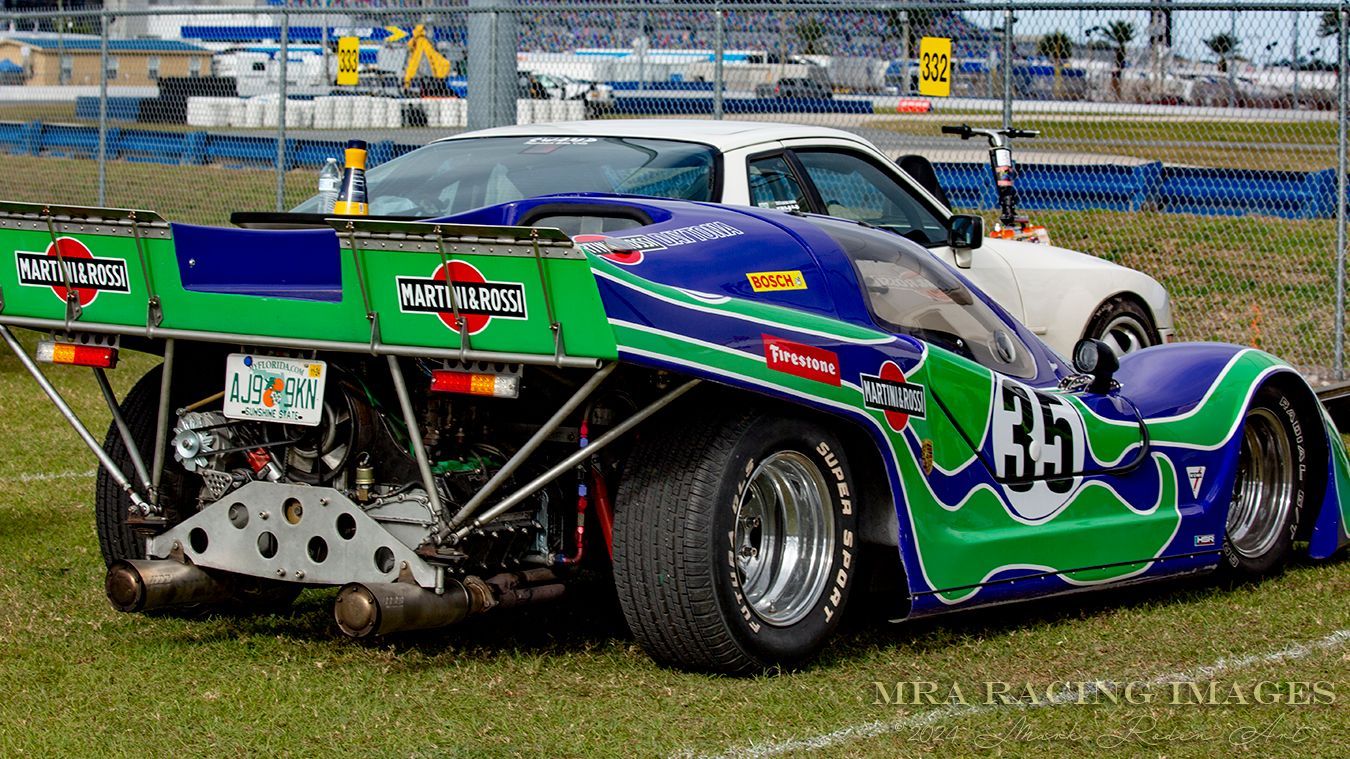
Race Weekend-Leading Up to the 24 Hours of Daytona.
Race weekend actually started Wednesday with the first Mazda MX-5 Cup practice and Michelin Challenge practice, continuing Thursday with more practice sessions and the Mazda and Michelin qualifying. Mazda ran their first race in the afternoon, and the day finished with a Weathertech night practice session.
Friday saw the final Weathertech practice session, the second of 2 Mazda MX-5 Cup races and the BMW M Endurance Challenge at Daytona for the Michelin Pilot Challenge, a 4-hour timed event.
Saturday: Race Day.
As the sun came up slowly from the east, brimming first onto the top of the main grandstands, then slowly working its way down through the lower sections, and finally onto the track and all of the RV’s and camping tents spread out across the grass of the infield, people began to wake up to the smell of coffee and smoldering campfires. The parking lots filled with cars and the fans walked through the tunnels, finding their way to seats, the fan zone, or the many other attractions gradually coming to life along the main infield road.
In the garage area, teams were preparing to do battle with each other over the course of the next day. Their cars prepared and their drivers well rested, they readied themselves for the bombardment of stress that would hit their bodies and minds over the next 24 hours, all waiting for the call to start engines.
As the field launched from pit road to the track, tensions became thick in the air. All of the problems and issues over the last week became meaningless to the extent that none of it mattered at this point; what had been resolved, was resolved. What hadn’t been would be wagered as irrelevant until it proved otherwise.
My first shots on race day were of the static display of historic race cars on full view in the fan zone. This included some very iconic GTP and other racing cars from the 70’s, 80’s and 90’s. The original GTP era existed from the early 80’s until the mid-90’s, when IMSA eliminated the class citing high costs and the tendency of manufacturers to lose interest and pull out of the series.
They were the fastest and most complicated track racing cars in existence, reaching speeds of up to 250 miles per hour. Their presence reminds me of the races I attended in the early days of my photography experience. Seeing them once again allowed me another level of appreciation for the racing that we have today, built on the shoulders of what those pioneering teams and individuals learned about speed all those years ago.
Today we have decades of technology built on the sheer determination to go faster, and to add a higher level of quality to the cars sold to the public. Not so long before them were steam engines, and carts pulled by horses. Not so long after them, we have electric cars and renewable energy concepts only dreamt about before. Today’s GTP are hybrids of all of that technology, building a new legacy and taking us into the future; a future that I hope will hold many more years of racing like the endurance race at Daytona.
Having had my fill of nostalgia for the day, I decided against the grid walk as, for one thing, the area was flooded with people. For another, I really needed to pace myself if I was going to last through the evening. I found myself in familiar territory at the start of the race; the same infield stands that I had used several times during practice, along the straight section of the road course between turns 3 and 5. I originally wanted to sit closer to the “Horseshoe” turn but those benches were completely full, so I walked along the fence until I got to that last set, where there was just enough room for one more photographer.
I have taken plenty of shots from this same area of the track, so there isn’t anything that I’ve missed here during the two years of practice sessions, qualifying and last year’s race. The essence of it is, I really like photographing race cars. I have taken the same shot dozens of times. It may be 50 different cars, but it’s the same shot. The fact is, I just love doing it, and I will continue to do it so long as that basic premise doesn’t change.
Here at Daytona, there are 9 or 10 great perches which are relatively short distances from each other, and from which you can get a good variety of work, whether it’s a pan shot or head-on shot; rear, front and side views, or any number of angled views. From most positions, shooting through the fence is quite easily accomplished, and save for a few spots with a double fence, it is a (mostly) unobstructed view.
As the opening laps unfolded, I settled in and got to work. Since I already had plenty of shots under my belt from previous days, I decided to practice my long shutter speed panning technique. One thing I like about sports car endurance racing, at least from a photographic standpoint, is that you have plenty of time to experiment, as opposed to sprint formats with shorter and fewer practice sessions and a race that is maybe 3 hours long, if you’re lucky. In a 24-hour race, time can be taken; I can spend hundreds of attempts to get a shot exactly how I want it, using techniques that have a relatively low-percentage of success, but highly optimum results if done correctly.
After the first hour, Ricky Taylor was in the overall lead with Sebastian Bourdais in the #01 Cadillac and Filipe Nasr not far behind in the #7 Penske Porsche. George Kurtz was leading the LMP2 class in the Crowdstrike Oreca, and behind them was a cluster of GTD / GTDPRO cars, led by Telitz in the #12 Vasser Sullivan Lexus. Two cautions slowed the action, one about a half hour into the race involving the #78 Forte Racing Lamborghini, and the second on the restart involving several cars including a gaggle of LMP2’s in the “Bus Stop” (I know, I know, Le…Mans…Chi…cane…) Another incident between the #20 LMP2 and #14 GTDPRO Lexus resulted in the Lexus slamming the back of the spinning LMP2 which ended up against the wall.
After all this I went for a quick bite and had a walk to the other side of the horseshoe turn. This was a good move as I managed to get some nice work out of it. I made a note to try and get back to this position later in the evening to take the iconic shot with the Ferris wheel in the background (spoiler: this never happened, but Cornell got some great shots of it which you can see toward the end of this report).
My time there lasted only about 10 minutes. There were so many people trying to get a spot along the fence that there wasn’t enough room for me to work effectively, so I walked back around finding a seat in the primary infield stand which sits just past the turn. I already had work taken from this spot during ROAR weekend, but at this time the lighting was a little better. I decided to repeat shots as much as possible, getting all of the cars in a few different “looks” as they entered and exited that turn.
The GTP lead had been changing hands between Louis Deletraz in the #40 Acura, the #24 BMW driven by Philipp Eng, and Scott Dixon at the helm of the #01 Cadillac. Also, after almost 2 hours in the garage, the #14 GTDPRO Lexus came back out on the track, about 25 laps down. This is the kind of thing I like to see in racing; a team that won’t quit even though their odds of winning are dashed.
The afternoon light was beginning to fade, and so I made the choice to switch lenses. For all but the start of the day (the garage and fan zone areas, where I used my 24-105mm/f4), I had been using a 100-400mm zoom lens with a 1.4x extender attached, which put me in the neighborhood of f8. I swapped it out for my primary 200mm f2.8 fixed lens which works much better in low light conditions. The lens, along with the abundant trackside lighting, made it possible to shoot all night. By this time, Pipo Derani had taken the lead in the GTP and overall standings, running ahead of the pair of BMW’s and a slew of Porsches including the Proton entry.
The fences at Daytona are easy to shoot through, and I like the low angle, so I stayed out of the stands and stood at the fence for a while. At 200mm the cars are close, so my success rate was lower. But when I got the shot, I really got it. Most of the GTD cars would fill the frame if I snapped just before they got to me. All of the others--the LMP2 and GTP cars--were too long to capture the entire car. So, I tried something new and angled the camera to catch them diagonally. It’s a little more angle than I typically use, but it worked for everything but the GTP Cadillacs. At that distance I would say something more like 150mm would have been the perfect focal length, so all of those shots are somewhat cropped.
I again experimented with very long shutter speeds, and although my hit rate was quite low, the 1 out of 20 that did make the cut justified the effort. I find it difficult to stand in one place for very long, so I continued to make my way down the fence line and stopped occasionally to take a few shots into the post-sunset evening hours.
I sat in the turn 5 stands for a while. I wasn’t really in the mood for further shooting at that point, so I just sat and enjoyed the race from outside the viewfinder. It is amazing how few times I have done this over the years. At the 6-hour mark the #7 Porsche had taken the lead and seemed to take off from the second place Caddy. Kurtz in the #04 Crowdstrike LMP2 had a commanding lead of 1 lap over second place #74.
The GTDPRO class was being led by the Paul Miller Racing #1 BMW, also with a 1 lap lead over the second place in class. At 8 hours Pipo Derani regained the lead from the #7 Porsche driven by Josef Newgarden. The #99 AO Racing Oreca was leading the LMP2 class, and the #1 BMW was still in the top spot for GTDPRO.
The race was now getting into full dark night hours, and the infield color was in full swing. Walking through the mix of campers, tents, fire pits and a great variety of lit up displays, custom lamps made from old pistons, and guys on hand-built pedestals and pineapple drinks taking in the race, you could smell barbecue cooking and hear all manner of people being people.
This event has been known for its infield spice, and this year was no different. A good time for all, and now and again you remember that there is a race on.
I was satisfied with my efforts up to that point and decided that I hadn’t anything further to prove, so I found my way back to the car with the idea that I probably would not return for sunrise.
Overall, my second-year experience of this race was a resounding photographic success. I found a few new shots for the archives and repeated many of the same shots from last year, but better; it was the first time at Daytona for the 1.4x extender as I had purchased it last year just before the Indianapolis 500 in May. I gained some newfound knowledge about sun patterns at the track and bits of information about how better to get around. All of this sets me up for next year, hopefully with even more success.
A Trackside Report from Cornell Chu:
This year was my third consecutive year attending the Rolex 24 as a fan. I've never had credentials for this race, but with such a variety of open vantage points you really don’t need them.
Daytona International Speedway is known for its wide variety of viewpoints from around the track easily accessible by spectators like me, such as the turns of the road course, the grandstand outside the front straightaway, and even a few vantage points in the infield with mostly unobstructed views of the speedway turns. This makes the experience infinitely better. This year’s Rolex 24 was no less than what I've experienced in the past two years.
With an exponential increase in the attendance of race fans, the atmosphere was ecstatic (as if it wasn't already). I had plans to be in and out of the track. But of course, things never go as planned. However, I did follow it quite well compared to other years.
I aimed to be at the track for the race start, sunset, nighttime stints, and sunrise in which I followed pretty well.
This year, I wanted to try and expand my toolbox like finding new compositions, exploring with different lighting scenarios etc. I ended with a barrage of new compositions which I'm very happy with. Taking the time to explore and think outside the box is helping to enhance my portfolio and sharpen my skills as a photographer.
You can share this report with your friends on Social Media using these links.
Do you like taking photographs and writing a few words? Get in contact, we need you!

